I felt it only fair to warn you that this will be a super long post! Not only does it have a bunch of pictures, but it also has a bunch of information. It was a long and busy day. . .
Back to Charleston for a day of walking the town, the bridge, a fort, dinner and a show turning into one of the most unique dates Blaine has ever taken me on!
On the way in, we saw this as we were driving by the Military Base – –
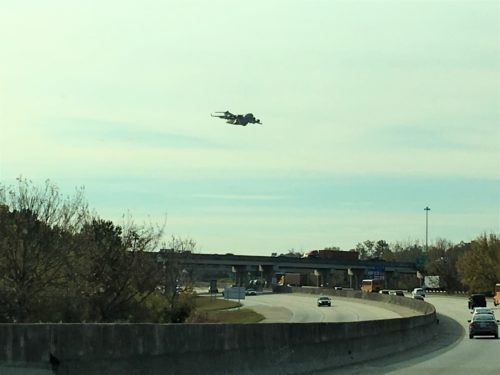 I
I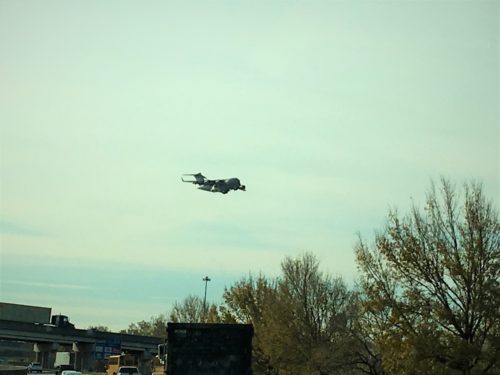
Today’s agenda was to seek out as many historic churches as we could walk to. We were sooo disappointed though that most of them weren’t open to the public – even the most historic one! How sad! The only ones open were Catholic. So while you’ll see pictures of a lot of places of worship, you’ll not see the insides. ☹
But with every stop, we hoped.
UPDATE: I couldn’t stand it. . . I found a website with pictures and took them with my cell phone on my computer screen. Not the best quality, but better than nothing! Besides, I wanted to know what they looked like inside!
The main reason Charleston is called The Holy City is that there are over 400 places of worship of all denominations, in just over 150 square miles. With a population of 134,000, if every single person attended that’d be 337 (and a half) people in each church. Most churches would be ecstatic with those numbers! 😊
Here’s the ones we visited today (fortunately for you, there’s only 9) and some snippets of information (Well, you know me by now. It’ll probably be more than a snippet if I get my nose into something I deem interesting):
- We had already stumbled upon St. Matthew’s Lutheran Church the other day so there won’t be pictures, but here’s some additional interesting information: It was constructed between 1867 and 1872. Its 297-foot steeple once made it the tallest building in South Carolina; it continues to possess the tallest spire. The congregation was originally founded by German-speaking Lutherans in 1840. In 1965, a fire destroyed much of the interior of the church and steeple, which crashed spectacularly into King Street. The damaged portions were carefully restored except for a finial (that’s a distinctive ornament at the apex of a roof) on the steeple. (It was cost-prohibitive at $500,000!) St Matthew’s is one of more than 1,400 historically significant buildings within the Charleston Old and Historic District. Aren’t you glad we didn’t visit them all?? 😊
- Cathedral of St. John the Baptist
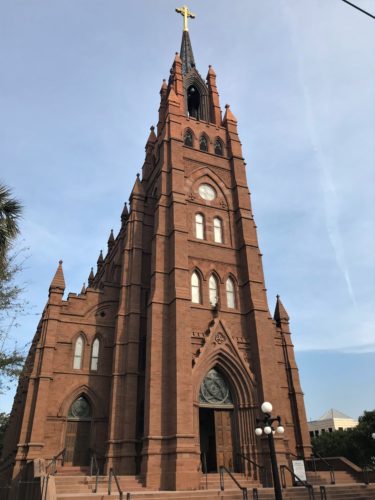
The cornerstone was laid in 1850 and consecrated in 1854. It could seat 1,200 and cost $103,000. On December 11, 1861 a factory fire destroyed much of Charleston including the cathedral and everything in it. After a 45-year fundraising effort, they were able to lay the cornerstone of this present building in January 1890. Early in the 2000’s a widespread appeal was made to make renovations, and add the spire from the original 1850 plans. It’s complete – 103 years later.
We were able to get into this one, however we felt we had to be really quiet because a man was sitting up front meditating.
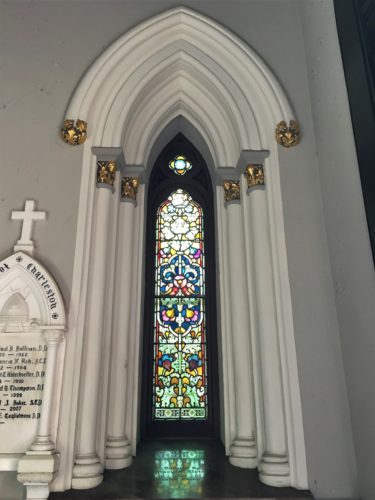
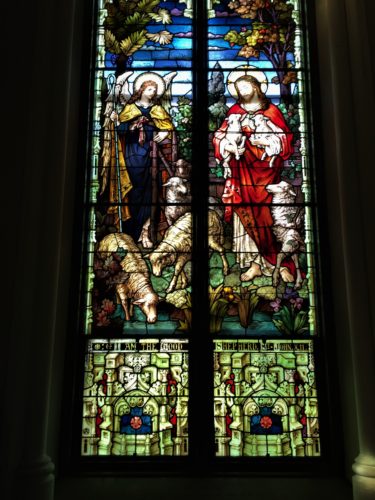
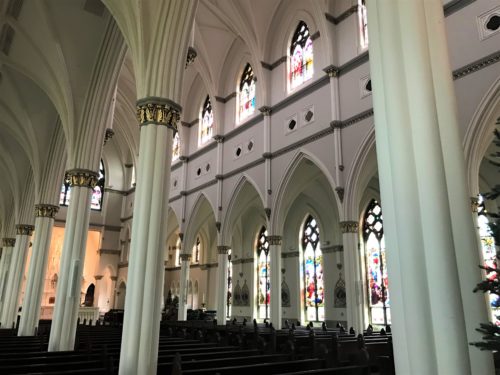
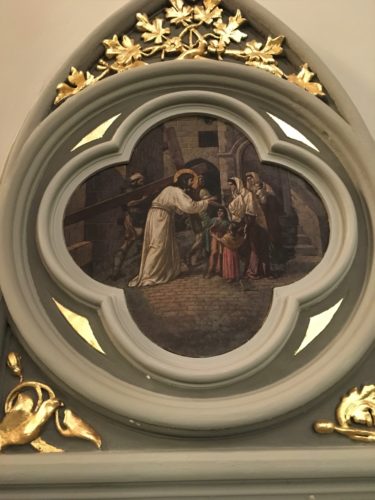
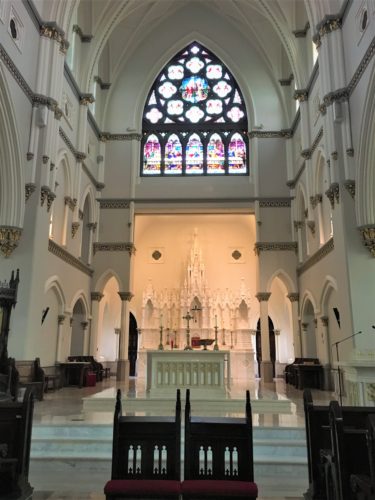
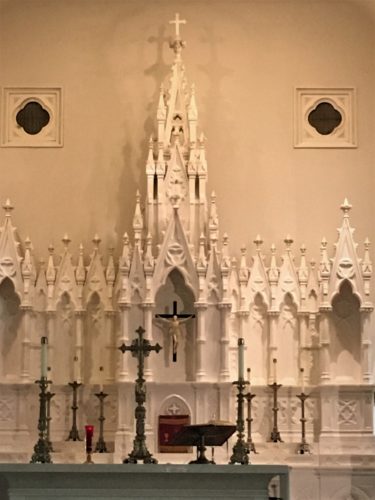
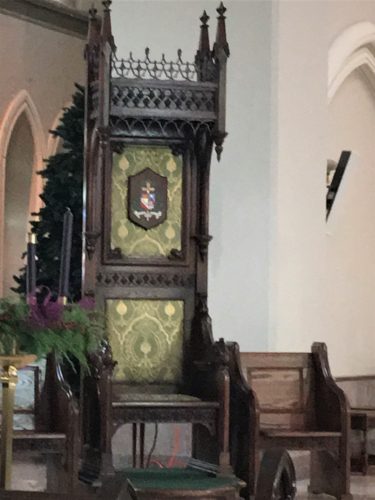
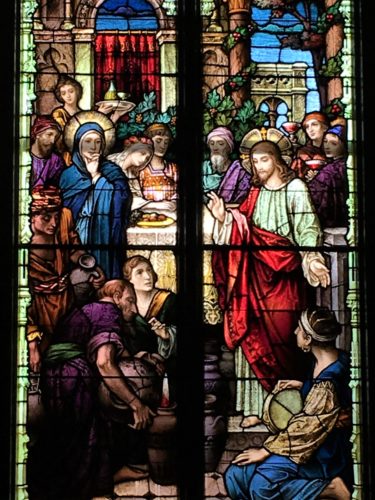
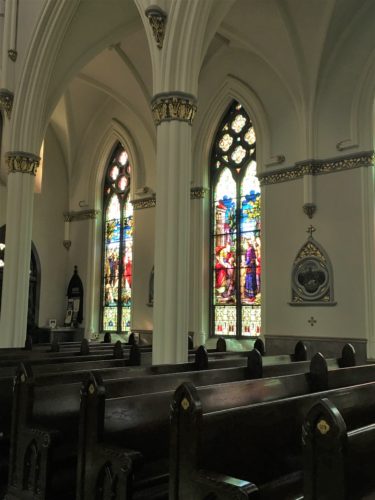
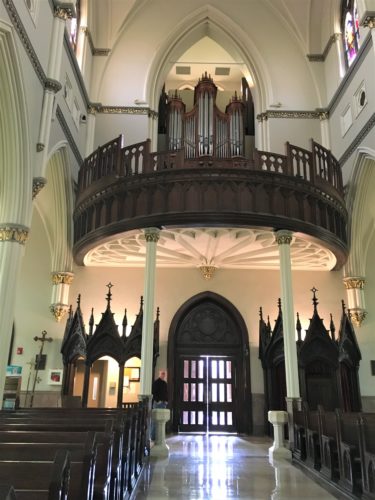
We think the one on the right is a confessional.
The left side is kinda like a bulletin board with information.
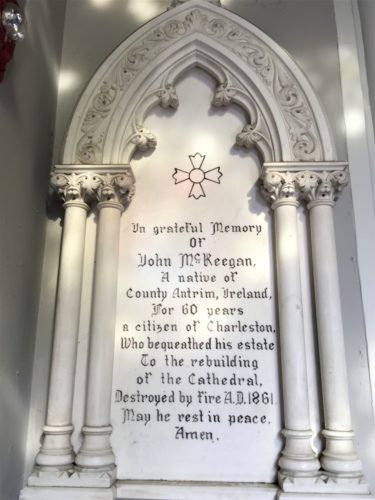
It’s probably best we couldn’t get in . . . you won’t have nearly as many pictures. : )
- St. Michael’s Episcopal Church
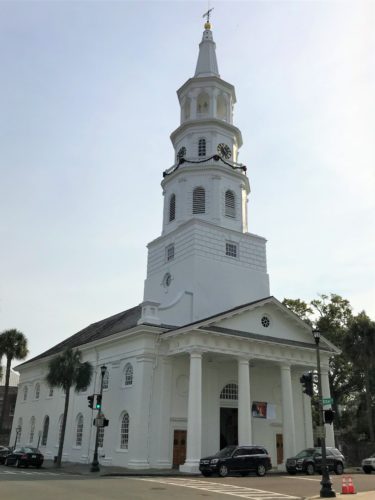
The church was built between 1752 and 1761 and is the oldest church in Charleston. It’s also one of the few in America to retain its original design. It sports a 186-foot high steeple that’s large enough to contain a ring of bells and a clock. The steeple also served as a navigational landmark for the harbor and as a look-out tower during the Revolutionary War, War of 1812, Civil War, Spanish-American War, World Wars I and II, as well as serving as a fire look-out tower until the late 1890’s. St. Michael’s has survived several hurricanes, wars, fires, earthquakes and a tornado with little alteration to its architecture. Whenever it has been damaged, the church has been carefully restored or reconstructed. The current portico dates to the late 1880s, and is a replica of the original which was damaged in the 1886 earthquake. The pews, including Number 43 used by George Washington in 1791 (when he visited the town – remember from a previous blog post??) and later by General Robert E. Lee in 1861, have recently been restored to their 18th century finish. St. Michael’s bells (which we never heard) are among the city’s most beloved treasures and were imported from England in 1764. During the Revolutionary War, the bells were taken to England as spoils of war, but a London merchant purchased and returned them.
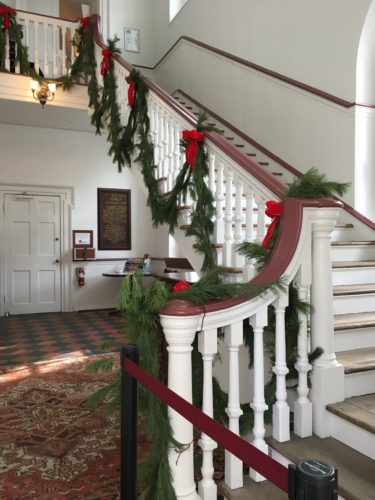
This is all the further we could get into this one
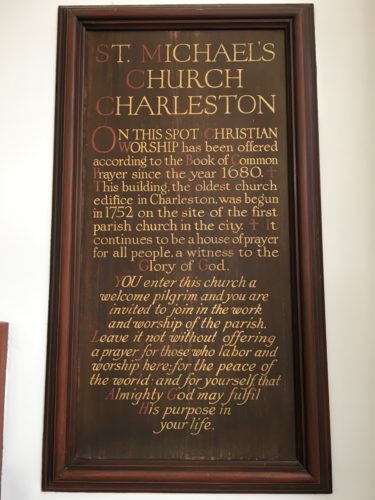
Oh, Look!! A Cemetery! This is the St. Michael’s cemetery. We didn’t walk through all of it. : )

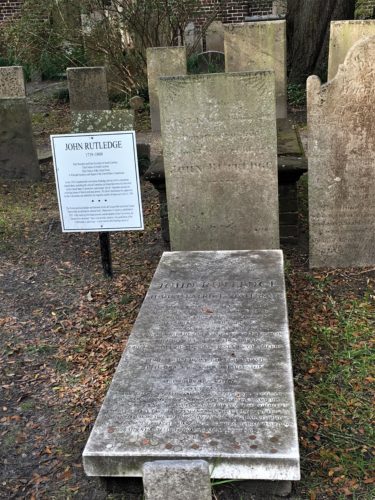
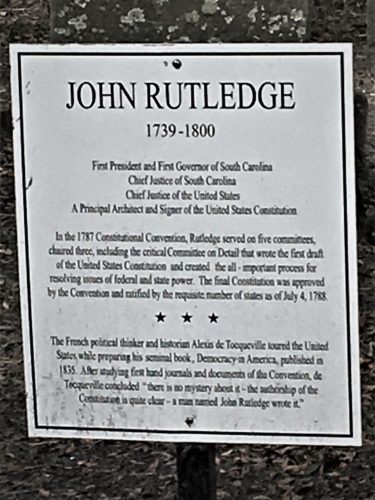
Take a close look at this sign.
It says John Rutledge was the first President of South Carolina . . .
What????
Here’s what I found out about that little tidbit:
Today I found out about the presidents before the U.S. Constitution went into effect.
Schools in the United States teach children from an early age that the first president of the United States was George Washington. But teachers often forget to mention a small, kind of important detail- George Washington was the first U.S. president under the current United States Constitution, but he wasn’t the country’s first president.
Before the U.S. Constitution came into being, the Articles of Confederation served as the glue which held all thirteen states together as a single country. (See: The Articles of Confederation: The Constitution Before the Constitution) The Articles went into effect in 1781, and they established a loose alliance among the states. The Articles also defined the role of Congress to oversee the national needs, as well as the office of the president.
Due to the fear of giving too much power to one person, the office of president was extremely limited in power and scope, and was not even a paid position. Rather, the primary roles of the president at this time were simply to preside over meetings and handle various state correspondence. The president was also the one who signed official congressional documents.
So who were these individuals who served such a lackluster position as the office of president?
The first president of the United States under the Articles of Confederation was John Hanson from Maryland. His term began in 1781 and ended in 1782.
Elias Boudinot of New Jersey became the second president, serving from 1782 until 1783.
Thomas Mifflin became the president for the term of 1783 until 1784.
Richard Henry Lee of Virginia served as the country’s fourth president from 1784 until 1785.
John Hancock, most famous for his large signature on the Declaration of Independence, held the position of the president from 1785 to 1786.
Nathaniel Gorham, also from Massachusetts, served as the president under the Articles of Confederation from 1786 until 1787.
The seventh president of the United States was a man from Ohio named Arthur St. Clair. He held the position between 1787 and 1788.
Cyrus Griffin of Virginia had a background in law before he became the eighth and final president of the United States under the Articles of Confederation. ~ taken from todayifoundout.com
If you want to know more about all this, you’ll have to research it yourself. My head hurts. . .
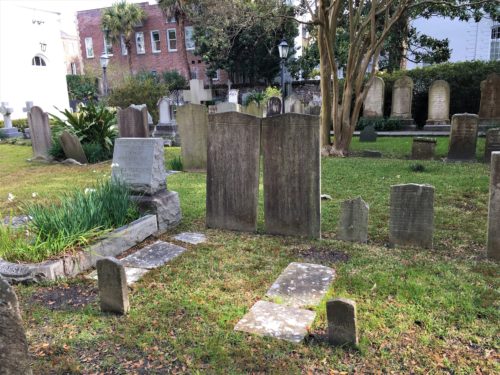
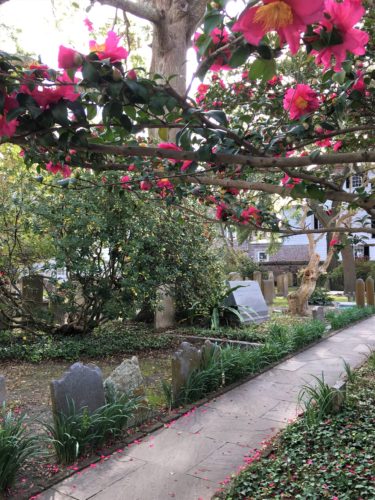
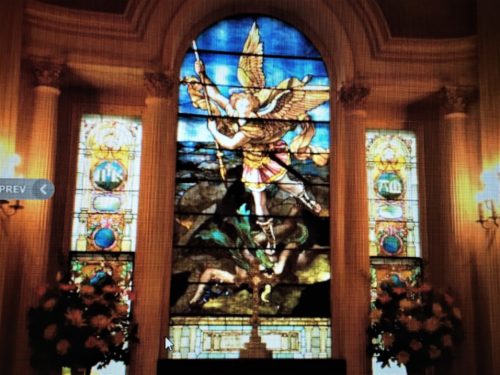
Inside St. Michael’s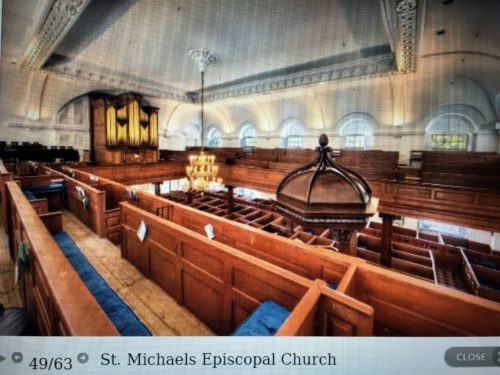
- First Scots Presbyterian Church
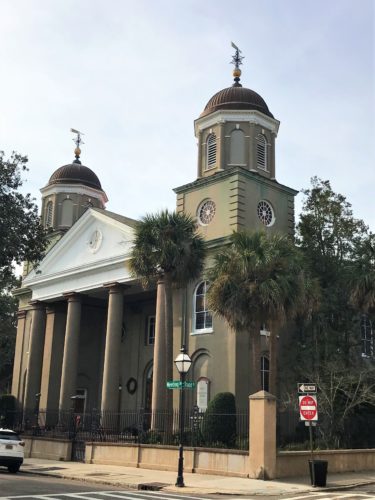
This is the fifth oldest church in Charleston and was constructed in 1814. It was designed by Benjamin Latrobe who is best known for designing the United States Capitol. The massive brick walls are three feet thick. The congregation dates to 1731 when 12 Scottish families withdrew from the Meeting House, located at the site where the Circular Congregational Church (see #8) now stands. During both the Revolutionary and Civil Wars, services were no held. (I don’t know why). Their original bell was given to the Confederate army to make cannons.
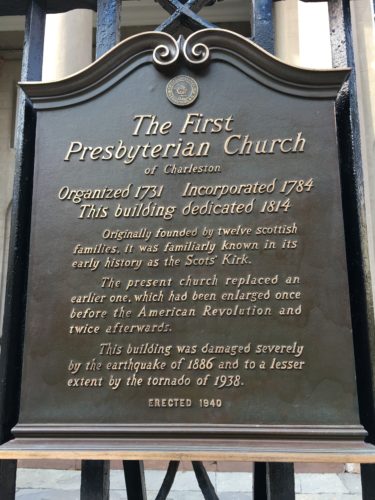
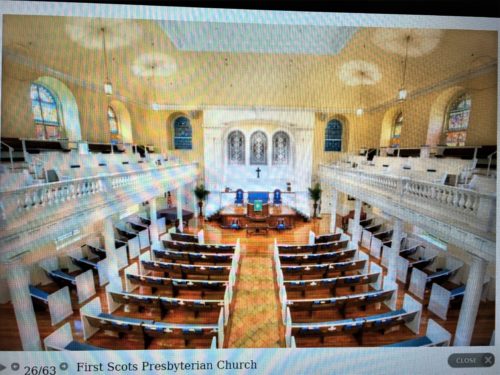
Inside Scots
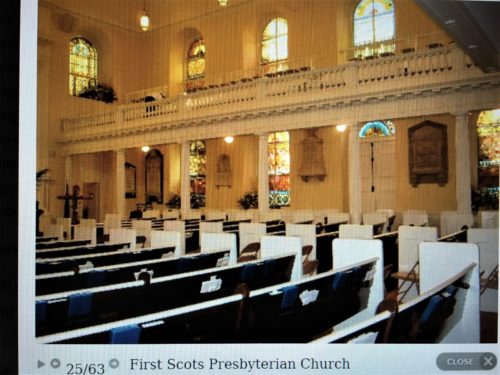
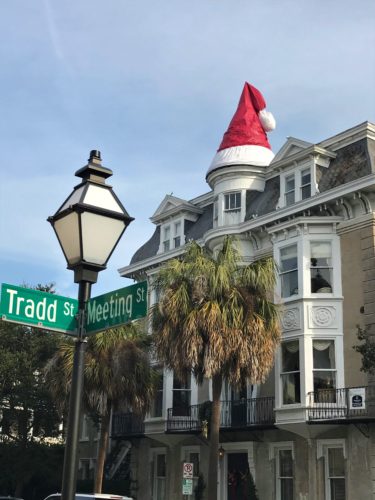
Take a look at this from across the street.
Ha Ha!! Cracked us up!! : )
- First Baptist Church

This is the True First Baptist Church – at least in the South. 😊 It’s often referred to as the “Mother Church of Southern Baptists” and is the oldest Baptist Church in the South. The building being dedicated in 1822, the congregation was first organized in 1682 in Kittery, Maine. Late in 1696, the pastor and 28 members immigrated to Charleston. By 1708, he reported 98 members. The history of the building after 1960 has been marked by three events: The Civil War, in which considerable damage was done by a shell which tore up the organ; the tornado of 1885 and the earthquake of 1886. After each disaster, the congregation restored the building. It also had to go through some areas of restoration after Hurricane Hugo in 1989. It has 2 pipe organs! The first, an Erban Organ circa 1847 and a Wicks Organ installed in 1992. Another interesting note, during the Revolutionary War, the Church was seized by the British and used as a storage facility for salt beef and other provisions. The British commander, Lord Cornwallis, “feared the prayers of the young Baptist minister more than the armies of Marion and Sumter.” The minister he spoke of was the Rev. Richard Furman, founder of Furman University in Greenville, South Carolina: the first Baptist college in the South.
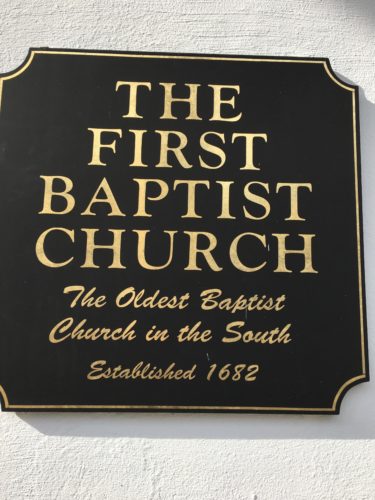
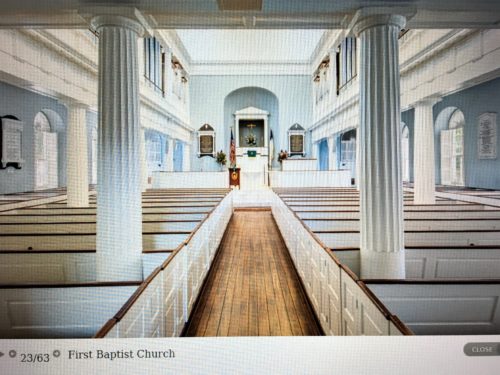
Inside First Baptist
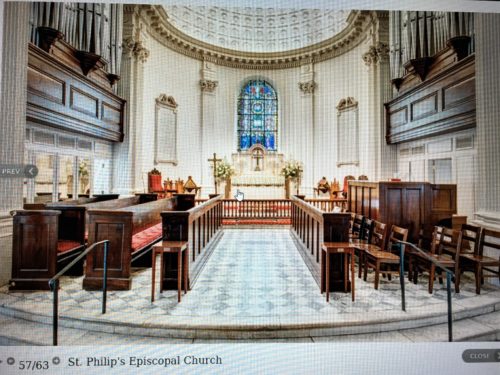
- St. Philips Church
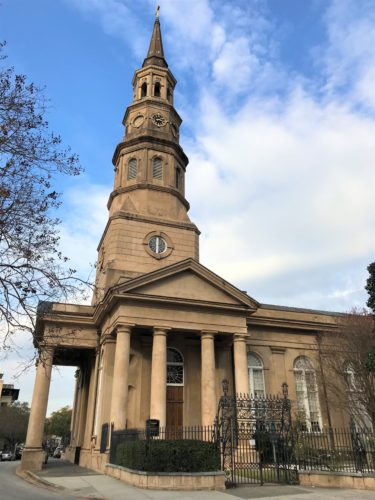
The bells were ringing! Waaayy cool!
The oldest congregation in South Carolina starting in 1681, just 10 years after the colony of Charles Town was settled. It was also the first Anglican church established south of Virginia. The current location is the third building to house this congregation and was built from 1835-1838. Everything except for the steeple. That was added 10 years later. The previous building, in the early 18th century was partially funded by duties on rum and slaves. After suffering from one fire that was extinguished by a black slave (who was given his freedom for this act), the church completely burned in 1835.
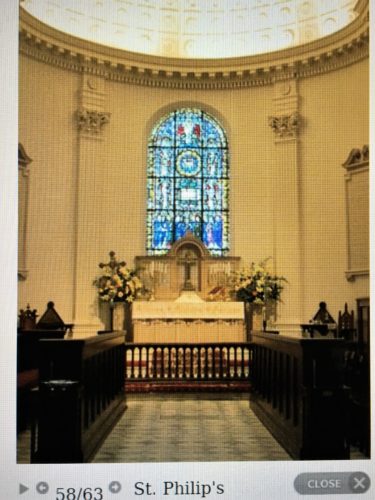
Here’s a few things I found interesting from the church’s website (with a couple of notes by me thrown in for good measure:
1680-81 – Just ten years after the colony was settled, Charles Town moved across the Ashley from Albemarle Point. The first St. Philip’s was built at the corner of Meeting and Broad, the present site of St. Michael’s.
1737 – George Whitefield (aka Whitfield – I recognized this name too. He’s the founder of Methodism) preached at St. Philip’s and was later expelled as a vagabond clergyman by Commissary Garden, after a hearing before an ecclesiastical court.
1751 – Due to a large increase in attendance at St. Philip’s, St. Michael’s was authorized to be built at Meeting and Broad streets. Ten years later, St. Michael’s held its first service.
1850 – John C. Calhoun, noted statesman, was buried in the West Church yard. During the War Between the States his body was moved to the East Church Yard near the chapel because it was feared that Federal troops might desecrate it.The massive tomb now sheltering his remains was erected by the State Legislature in 1880.
Here’s a side piece on Calhoun, copied from usabiographies. I recognized the name, but knew (or remembered) nothing about him.
A Biography of John Caldwell Calhoun (1782-1850)
March 18, 1782 in South Carolina, Calhoun was born, and educated at Yale College. From 1808 to 1810 an economic recession hit the United States and Calhoun realized that British policies were ruining the economy.
He served in South Carolina’s legislature and was elected to the United States House of Representatives serving three terms. In 1812, Calhoun and Henry Clay, two famous “warhawks”, who preferred war to the “putrescent pool of ignominous peace”, convinced the House to declare war on Great Britian.
Calhoun was secretary of war under President James Monroe from 1817 to 1825 and ran for president in the 1824 election along with four others, John Q. Adams, Henry Clay, Crawford, and Andrew Jackson. However, Calhoun withdrew from the race, due to Jackson’s support, and ran for vice president unopposed.
Calhoun was vice president of the United States in 1824 under John Quincy Adams and was re-elected in 1828 under Andrew Jackson.
Jackson was for the Tariff of 1828 and caused Calhoun to be opposed to Jackson, which led to Calhoun’s resignation in 1832. Because he could not do anything about Jackson’s views toward tariffs, which benefited only industrial North and hurt slaveholding South, John C. Calhoun became the first vice president to resign. (On October 10, 1973 Vice President of the United States Spiro Agnew resigned after being charged with federal income tax evasion.)
Calhoun wrote an essay about this conflict, “The South Carolina Exposition and Protest”, in which he asserted nullification of federal laws, and in 1832 the South Carolina legislature did just that. The next year in the Senate Calhoun and Daniel Webster opposed each other over slavery and states’ rights in a famous debate. In 1844 President John Tyler appointed Calhoun secretary of state. In later years he was reelected to the Senate, where he supported the Texas Annexation and defeated the Wilmot Proviso.
John Caldwell Calhoun died from tuberculosis in Washington, D.C. on March 31, 1850 and was buried in St. Phillips Churchyard in Charleston. In 1957, United States Senators honored Calhoun as one of the five greatest senators of all time.
And another bit from history.net:
Slavery was the foundation of the antebellum South. More than any other characteristic, it defined Southern social, political, and cultural life. It also unified the South as a section distinct from the rest of the nation.
John C. Calhoun, the South’s recognized intellectual and political leader from the 1820s until his death in 1850, devoted much of his remarkable intellectual energy to defending slavery. He developed a two-point defense. One was a political theory that the rights of a minority section — in particular, the South — needed special protecting in the federal union. The second was an argument that presented slavery as an institution that benefited all involved.
Calhoun’s commitment to those two points and his efforts to develop them to the fullest would assign him a unique role in American history as the moral, political, and spiritual voice of Southern separatism. Despite the fact that he never wanted the South to break away from the United States as it would a decade after his death, his words and life’s work made him the father of secession. In a very real way, he started the American Civil War.
Back to the church website:
1861 – A chime of eleven bells was contributed to the Confederate military cause to be melted down and re-cast as weaponry and ammunition. Four bells were replaced in 1976 by a group of church women who raised the money to install them in the steeple.
1860-65 – St. Philip’s steeple was targeted for shelling by the invading Union Army. One shell exploded in the churchyard during a Sunday service. The service was completed, but worship was moved to St. Paul’s Church on Coming Street.
1865-77 – The city was occupied by Federal troops until the end of Reconstruction. During the next twelve years, the church was gradually repaired.
1886 – On August 31, a major earthquake occurred, creating disaster for the church and many members of the congregation. Two thousand buildings were severely damaged or destroyed.
1921- A fire in the chancel area did much damage. Enlargement and improvement followed this disaster.
1989 – Hurricane Hugo caused severe damage to the church. Restoration costs totaled 4.5 million dollars.
- French Huguenot Church (aka French Protestant Church) Now there’s another name I recognized, but didn’t know – the Huguenot’s. Guess what? I’m going to learn and then teach you! (Well, more likely copy and paste . . .) 😊
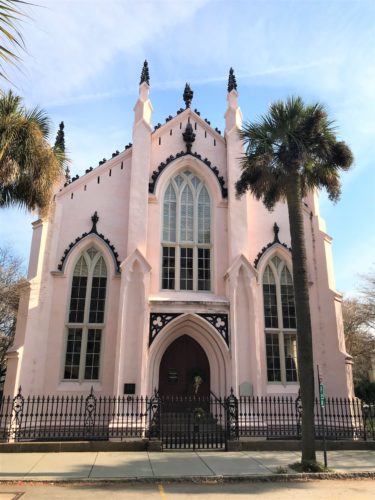
The words Huguenot, Huguenots, are old French words, common in fourteenth and fifteenth-century charters. As the Protestants called the Catholics papistes, so the Catholics called the protestants huguenots. The Protestants at Tours used to assemble by night near the gate of King Hugo, whom the people regarded as a spirit. A monk, therefore, in a sermon declared that the Lutherans ought to be called Huguenots, as kinsmen of King Hugo, inasmuch as they would only go out at night as he did. This nickname became popular from 1560 onwards, and for a long time the French Protestants were always known by it.
The Huguenots were French Protestants most of whom eventually came to follow the teachings of John Calvin, and who, due to religious persecution, were forced to flee France to other countries in the sixteenth and seventeenth centuries. Some remained, practicing their Faith in secret.
The Protestant Reformation began by Martin Luther in Germany about 1517, spread rapidly in France, especially among those having grievances against the established order of government. As Protestantism grew and developed in France it generally abandoned the Lutheran form, and took the shape of Calvinism. The new “Reformed religion” practiced by many members of the French nobility and social middle-class, based on a belief in salvation through individual faith without the need for the intercession of a church hierarchy and on the belief in an individual’s right to interpret scriptures for themselves, placed these French Protestants in direct theological conflict with both the Catholic Church and the King of France in the theocratic system which prevailed at that time. Followers of this new Protestantism were soon accused of heresy against the Catholic government and the established religion of France, and a General Edict urging extermination of these heretics (Huguenots) was issued in 1536. Nevertheless, Protestantism continued to spread and grow, and about 1555 the first Huguenot church was founded in a home in Paris based upon the teachings of John Calvin. The number and influence of the French Reformers (Huguenots) continued to increase after this event, leading to an escalation in hostility and conflict between the Catholic Church/State and the Huguenots. Finally, in 1562, some 1200 Huguenots were slain at Vassey, France, thus igniting the French Wars of Religion which would devastate France for the next thirty-five years.
The Edict of Nantes, signed by Henry IV in April, 1598, ended the Wars of Religion, and allowed the Huguenots some religious freedoms, including free exercise of their religion in 20 specified towns of France.
The Revocation of the Edict of Nantes by Louis XIV in October, 1685, began anew persecution of the Huguenots, and hundreds of thousands of Huguenots fled France to other countries. The Promulgation of the Edict of Toleration in November, 1787, partially restored the civil and religious rights of Huguenots in France. (Here’s a side note on King Louis – – one of his recorded quotes was “It is legal because I wish it.”)
Since the Huguenots of France were in large part artisans, craftsmen, and professional people, they were usually well-received in the countries to which they fled for refuge when religious discrimination or overt persecution caused them to leave France. Most of them went initially to Germany, the Netherlands, and England, although some found their way eventually to places as remote as South Africa. Considerable numbers of Huguenots migrated to British North America, especially to the Carolinas, Virginia, Pennsylvania, and New York. Their character and talents in the arts, sciences, and industry were such that they are generally felt to have been a substantial loss to the French society from which they had been forced to withdraw, and a corresponding gain to the communities and nations into which they settled.
Now that we know how they got here, let’s look at what happened in North America (according to the church’s website):
In April of 1680 the ship Richmond arrived in Charleston with 45 French Protestants (Huguenots) aboard. More refugees followed, and in 1687, a church was built on what is now the corner of Church St. and Queen St. in downtown Charleston. About four hundred and fifty Huguenots had settled in the Low Country of South Carolina by 1700.
The original church was destroyed in 1796 in an attempt to stop the spread of a fire, which had burned much of the surrounding area. The replacement for the original building was completed in 1800 and dismantled in 1844 to make way for the present Gothic Revival edifice, designed by Edward Brickell White and dedicated in 1845. The church was damaged by shellfire during the long bombardment of downtown in the War Between the States and was nearly demolished in the severe earthquake of 1886.
Today, the services are no longer in French except once a year, and worshipers no longer arrive in boats as they did when this was known as “The Church of the Tides”. However, the church is alive and well and growing in both membership and program. Attendance is at an all-time high.
Worshipers of all Christian backgrounds are welcome, and the church attracts a large number of visitors owing to Charleston’s vibrant tourism. In addition, the Sunday worship is followed by a light meal known in the church as the collation. Wine is served in the French tradition. (Well nowadays, that probably accounts for the higher attendance! 😊)
The current building was completed in 1845. The use of iron for the decorative details was unusual for the time, but reflects the difficulty of obtaining carved stonework during the antebellum period in Charleston. The church remains unaltered since it was built and even the clear glass windows are original.

- The Circular Congregational Church There’s an inside picture along with my recollection of our concert there to end our day today.
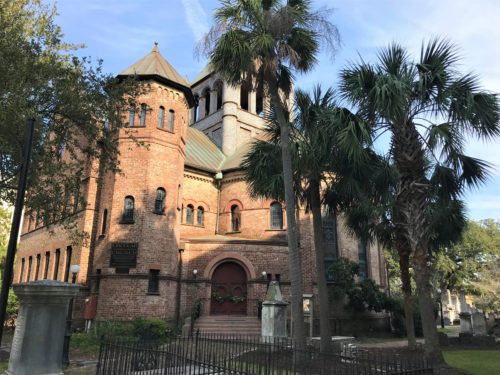
This is the site of the oldest continuously worshiping congregations in the South. Charles Towne’s original settlers founded this protestant, or dissenting, church about 1681. They have the city’s oldest burial grounds with monuments dating from 1695. (We were sad, but you’re probably glad – – the grounds were closed when we were there. ☹ ) Their first meeting house on this same site gave Meeting Street its name. Their vast, circular hall that was built in 1804, burned the 1861 fire, however bricks from that building were used to build the present sanctuary that was completed in 1892. The only artifact that remains from the 17th century is the brick grave structure of the Simonds family. It dates from 1695.
As with other churches, a British cannonball burst in the graveyard during Sunday services in 1780. They also suffered from earthquake, fire and vandalism. However, the recently restored graveyard is unmatched in the South as a repository of distinguished funerary art.
SEE!!! It’s ART!!!! And now I also know that Blaine and I could be considered “Aesthetes”! That’s a person who has or professes to have refined sensitivity toward the beauties of art or nature. I feel soooo much better! Don’t you??? 😊
When the British captured Charleston in 1780, it was bitterly rewarded for its love of freedom by the illegal exile of 38 heads of families to St. Augustine (in Spanish territory) and then to Philadelphia. There families were left destitute in an occupied city. The Meeting House, vacant since the cannonball episode, was used as a British hospital and left it a shell.
Here’s an excerpt from the church’s website:
The first major domed building in North America, it was described by one observer in 1818 as “the most extraordinary building in the United States.” However, people made fun of the fact that the church lacked a steeple and for years laughed at the rhyme:
Charleston is a pious place
And full of pious people
They built a church on Meeting Street
But could not raise the steeple
The people of Circular Church, as it was now popularly called, stopped the laughter in 1838 by raising a New England-style steeple that towered 182 feet above Meeting Street.
During the “glory days” of 1820-1860, Circular Church had a large congregation of white and black members. The first Sunday School for religious education in South Carolina was started here in 1816, great fire started near the Cooper River. During the night, a “hurricane of fire” swept all the way across the city, leaving in its wake the ruins of Old Circular. The Civil War soon followed with its devastating effect. The black members of the church withdrew in 1867 to form Plymouth Congregational Church. The psychology of defeat continued to demoralize the church for more than a decade, and it was a chastened and much reduced congregation that gathered the brick from the overgrown ruins of the great 1804 meeting house and began erecting a new sanctuary in 1890.
The Independent or Circular Church joined the Congregational Association in 1882 and continued its membership when this organization became the United Church of Christ in 1957. Circular also joined the Atlantic Presbytery of the United Presbyterian Church (U.S.A.) in 1968. It is one of the few congregations in the South that expresses its ecumenical commitment by belonging to two denominations, the U.C.C. and the Presbyterian Church (U.S.A.).
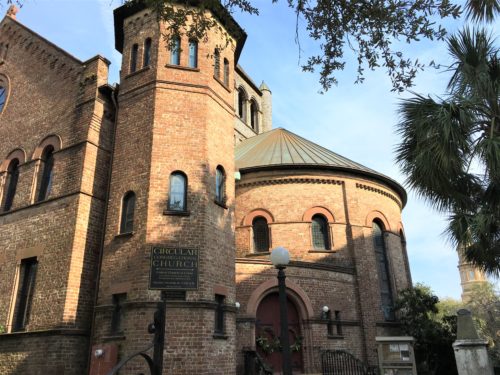

We don’t know what this is
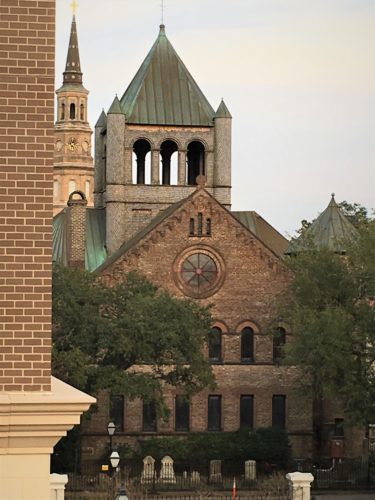
View of the Circular Church and St. Philips from our parking deck
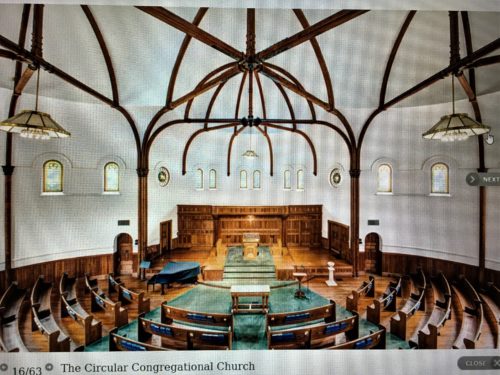
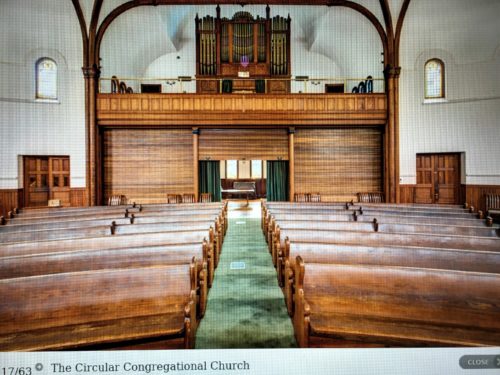
- Kahal Kadosh Beth Elohim (Jewish synagogue)

I found the least amount of information on this one. It’s the country’s second oldest synagogue and the oldest in continuous use. In 1792, construction of the largest and most impressive synagogue in the United States was commenced and subsequently dedicated 2 years later in 1794. This building was destroyed in a fire in 1838. They began replacing it with the current building in 1838 and dedicated it in early 1841.
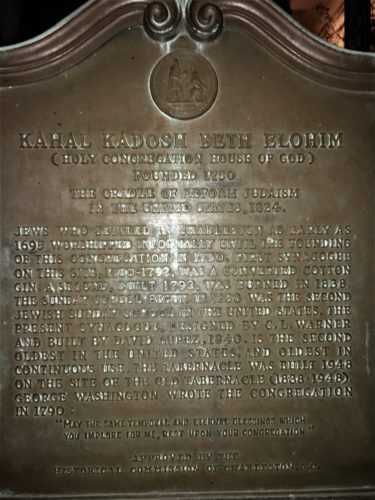

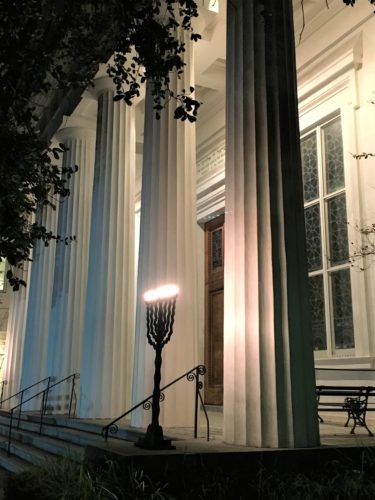
The Menorahs were lit for Hanukkah
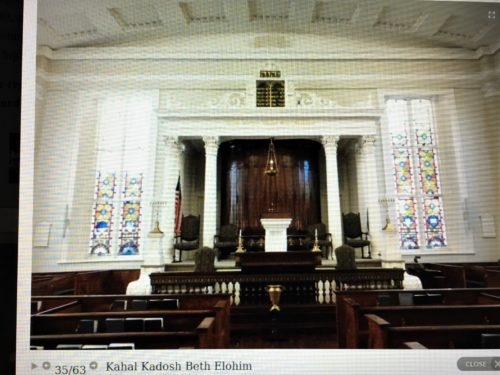

In our wandering around town, we ran across a few other sites besides churches. One of the more interesting things we learned – and this from a security guard – was about The Four Corners of the Law. This is unique to Charleston in that this is the only city in America that can claim this distinction. It describes the four buildings on the corners of Meeting and Broad Streets. In looking for the names of the streets, I learned the term was coined by Robert Ripley back in the 1930’s . . . Believe it . . or Not!
The four corners refer to – Municipal Law (city), State Law (Charleston County Courthouse), Federal Law and God’s Law.
Blaine had read somewhere to stop in to see the County building. This is where we learned about the Four Corners. I got a bit concerned that we were somewhere we weren’t supposed to be when we walked in the door and were immediately greeted by two guards and an x-ray machine! And then the guard asked what our business was here . . . But Blaine is so confident, he just told him we were tourists and had heard to stop by. The guard then was quite gracious and told us to go anywhere on the first and second floors. That even though there were signs saying court was in session, to ignore them and go in.
We were awe-struck by what we discovered! I can’t count how many times “WOW” escaped our lips – both out loud and whispered reverently.
These were the most beautiful courtrooms I’ve ever seen! (Well, that makes it sound like I’ve been in a lot of courtrooms, doesn’t it? I’ve actually only been in one. For a speeding ticket many, many years ago and I was so terrified, I couldn’t begin to tell you what the room looked like!)
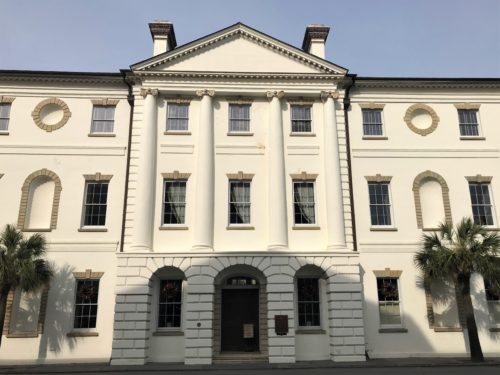
The Charleston County Courthouse
Constructed in 1792
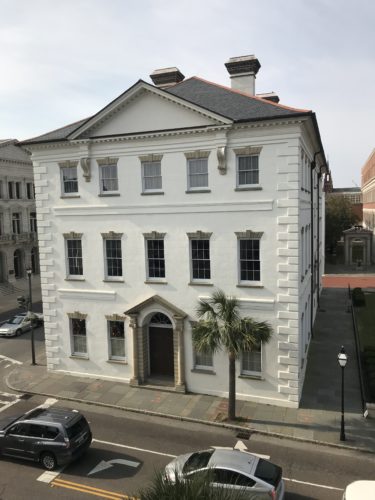

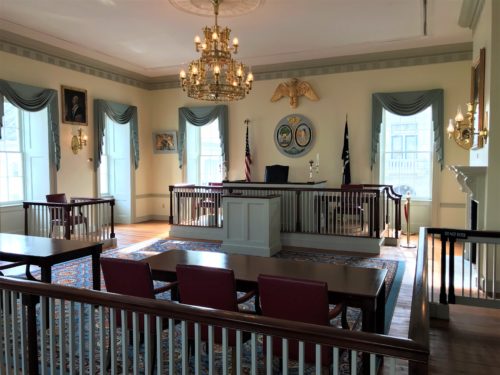
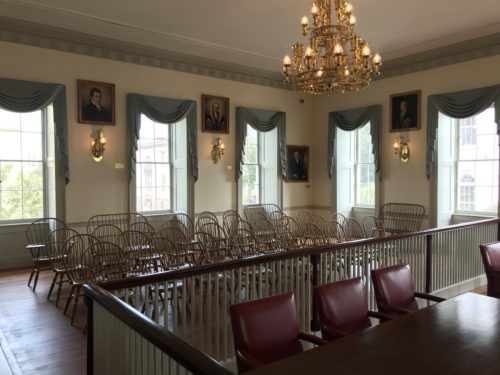
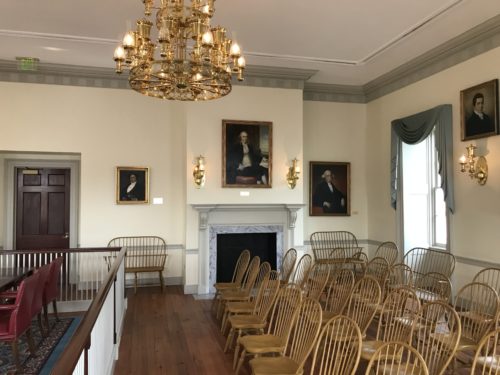
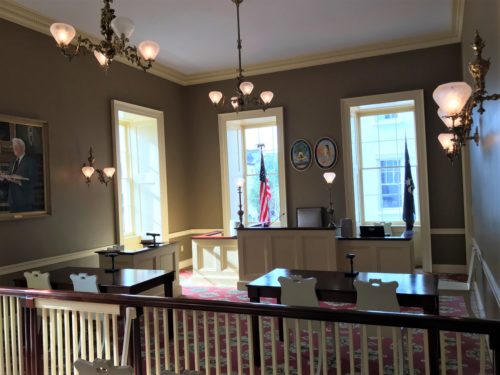
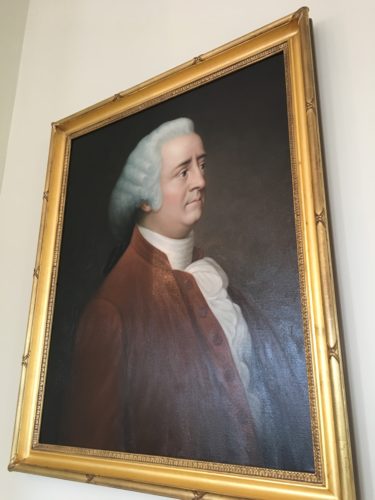
This is John Rutledge, the first President of South Carolina and also the first Governor.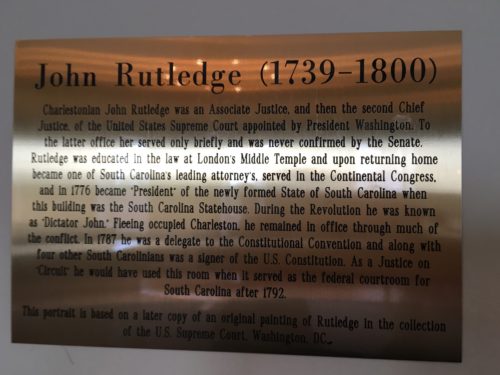
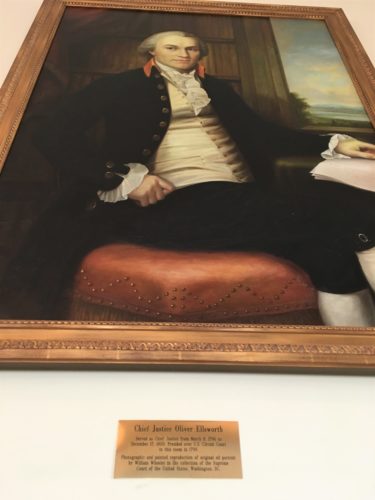
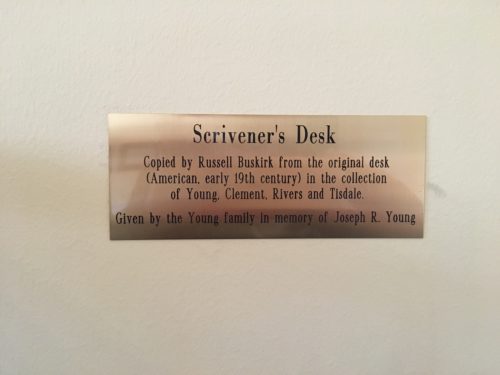
Never heard of that, but essentially, it’s a desk used by scribes. AKA people who write out official documents.
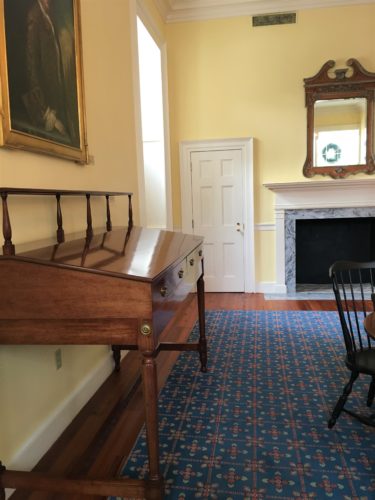
And here’s what the desk looks like. They had one of these in several rooms we looked into.
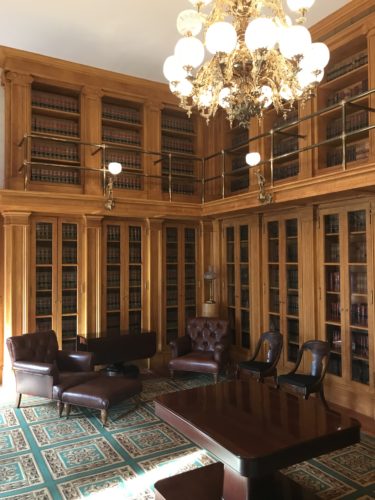
Just look at this Law Library! All these books are original! You can no longer get to the top – – they removed the ladder.

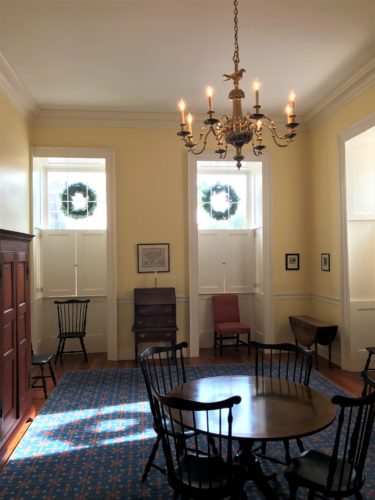
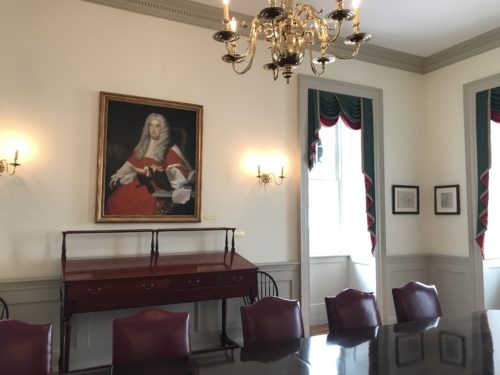
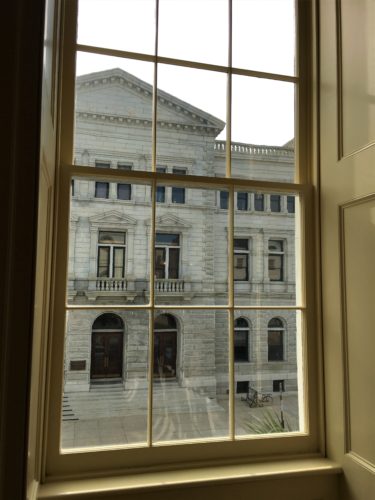
View of the Federal Building
The Charleston Post Office is housed in the first floor.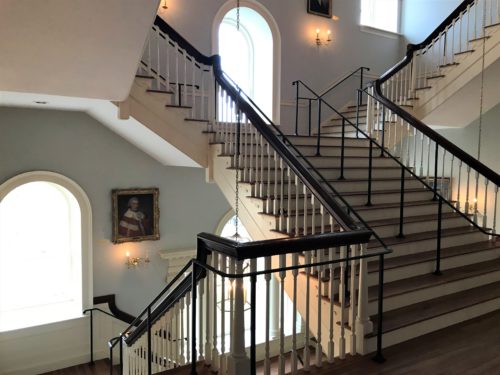
Next, we have the Municipal building.
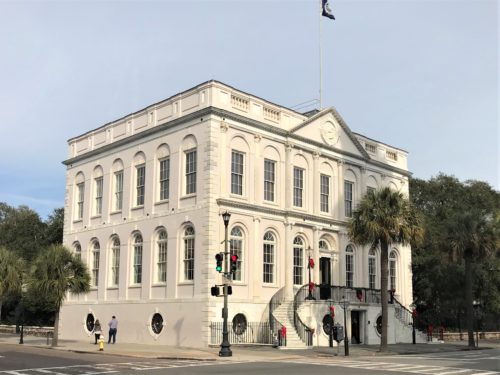
Built originally as a branch of The First Bank of the United States in 1801, it became City Hall in 1818.


The former bank vault.
Blaine was talking to the security guard.
The guard must have said something humerus! : )
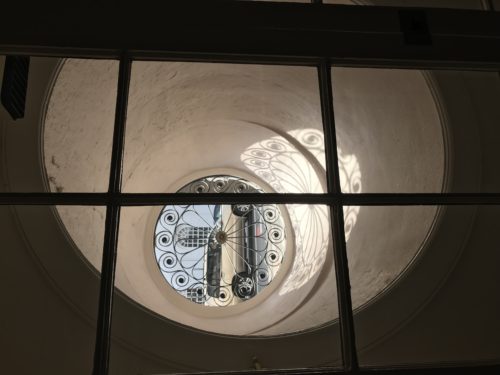
Just look how thick the walls are!
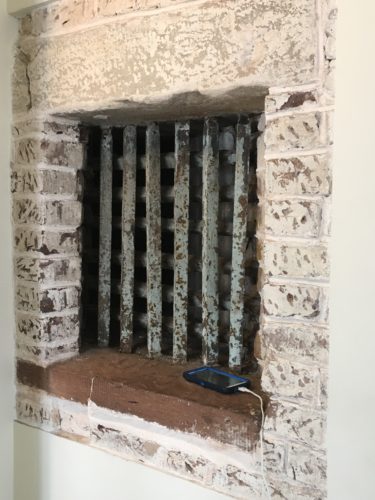
Ignoring the cell phone left here by someone (??), this is a cut out to show what the walls of this former bank-turned State building look like.
Incredible!

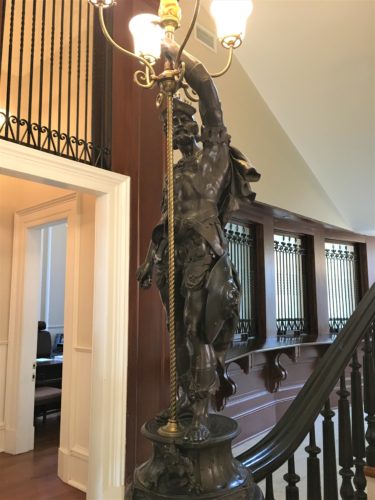
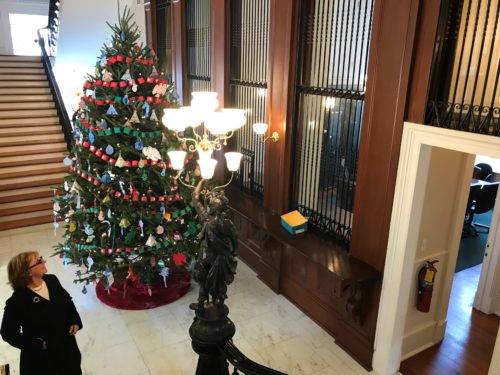
We weren’t able to see inside the courtrooms at City Hall on the third floor because court was in session, but we were able to walk around and visit other floors. We’d been told to see the original portrait (by another friendly security guard!) of George Washington on the Second Floor, but until I started looking for the date this building went from a bank to City Hall, I didn’t realize it was done specifically for this town!
There was a local custom of commissioning artists to paint portraits of famous visitors. John Trumbull’s valuable Portrait of George Washington was made during his tour in 1791!
There were other famous portrait’s there as well, we just didn’t realize it.
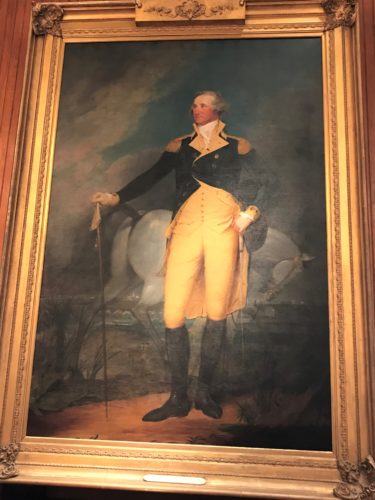
An original portrait of George Washington
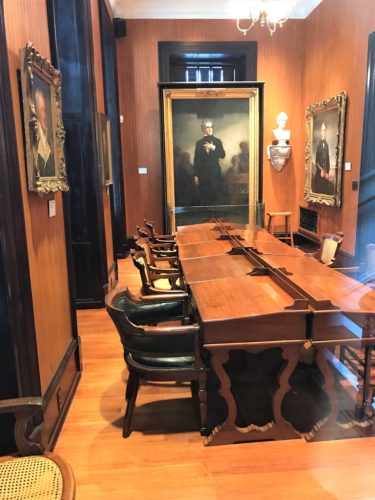
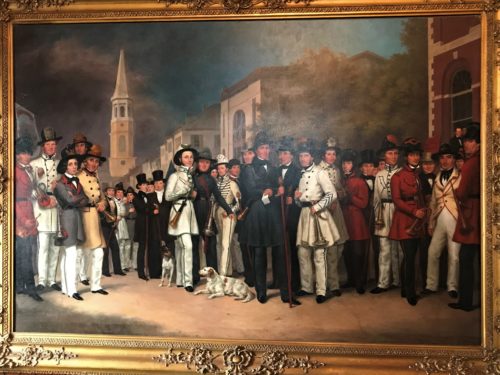
This is the Charleston Fire Department from the 1800’s, I believe. I forgot to take a picture of the description and now neither of us can remember . . .
But seriously, how in the world did they fight fires in those get-ups?
It’s no wonder Charleston burned in
1838 and 1861!
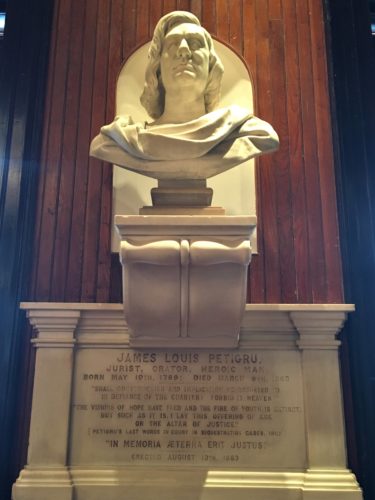
Up next – – the Federal Building. It was built in 1896 and the Charleston Post Office is on the first floor. That’s the only part we were in. Wait till you see this!
My aunt was a postal worker in Uniontown, Ohio. Back in the day, she intercepted all the mail that came addressed to Santa and she’d answer all the letters and send them back! How cool is that! Can you just imagine how excited those kids must have been to get a letter from Santa? Nowadays, she’d probably be arrested.
Anyway, I can remember her taking me to work with her once in a while on Saturday’s and letting me help her sort the mail into those little slots. We also ran it through a canceling machine. Fun!! That post office is now Dr. Mead’s dental office. He happens to be our dentist. (Don’t worry, I’m getting to the point) The first time I opened his door, I had this flashback to walking into the old post office! Isn’t it amazing how God created our minds!
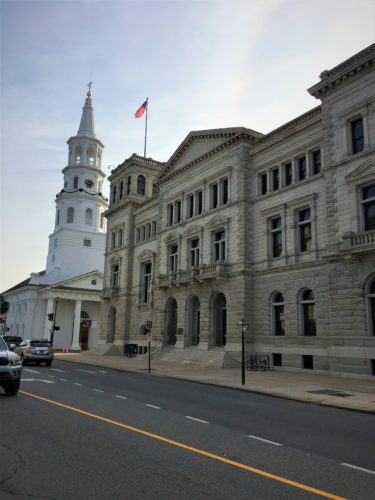
The Federal Building.
St. Michael’s is (God’s Law) is in the background
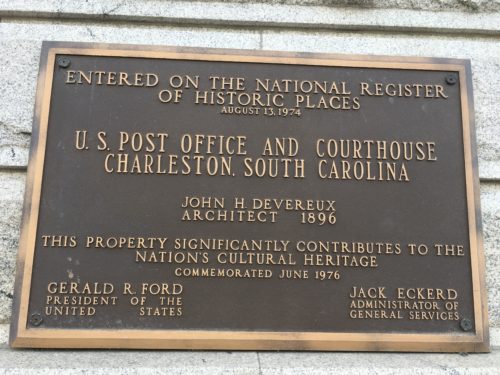
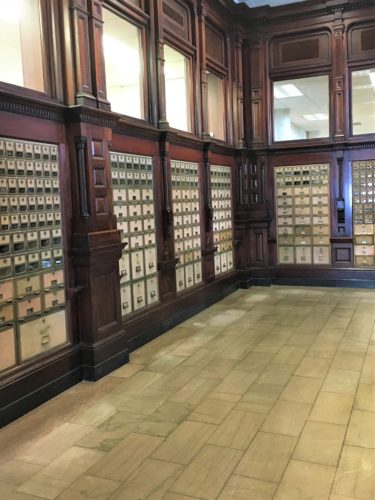
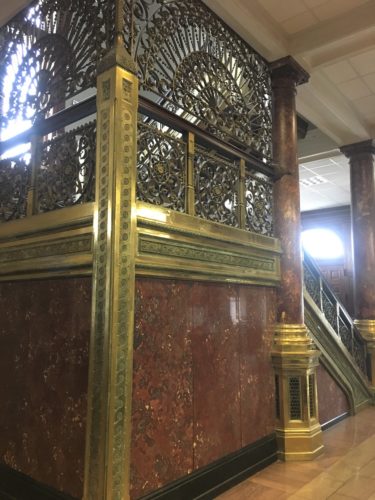
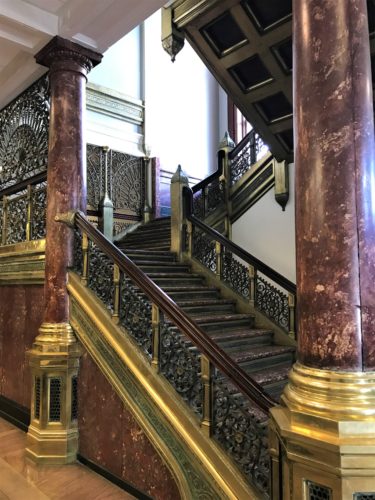
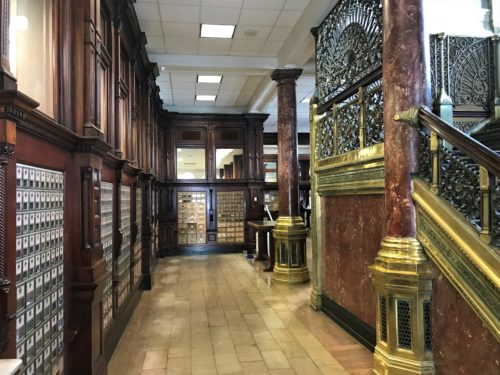
They had a small Post Office Museum which was interesting as well – especially the pictures of postal workers from the early years!

Look at the craftsmanship in the wood!

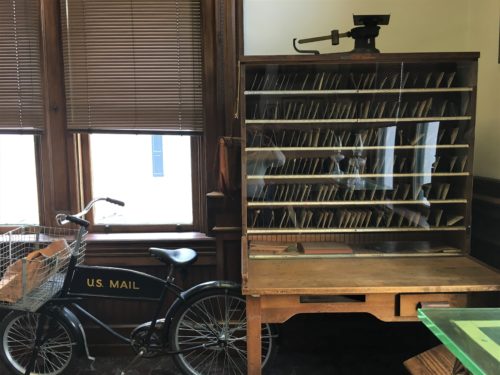
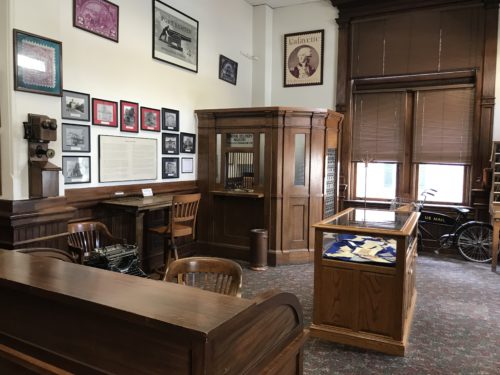
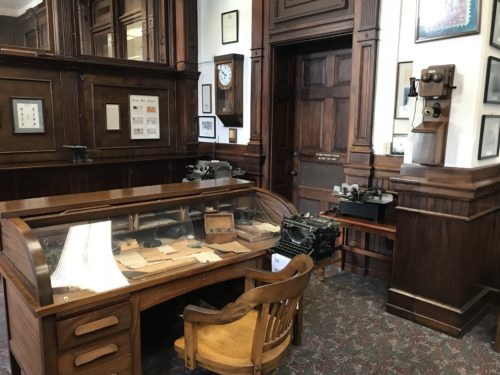
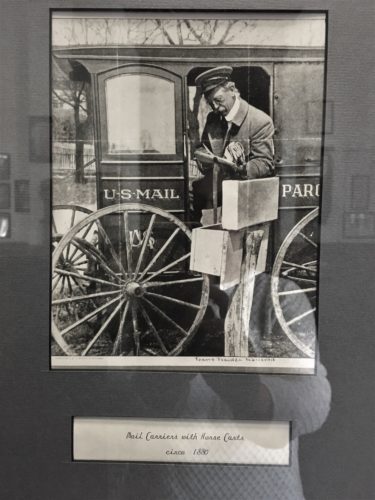
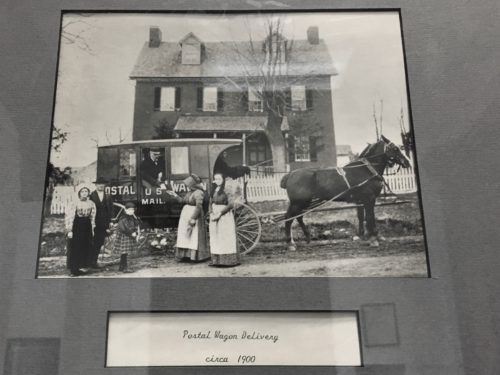
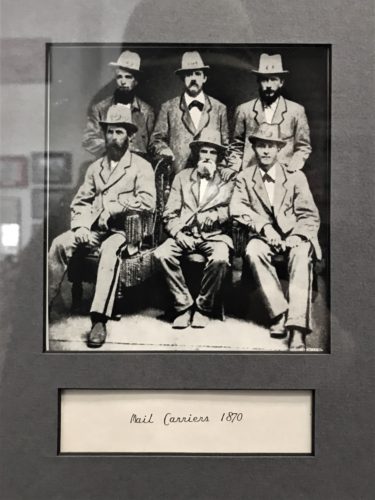
We already covered St. Michael’s Church in the “historic churches” section, so we’ll skip that part. : )
Here’s some other things we spotted as we were walking around town. Just a few of the 1,400 historic places. : )
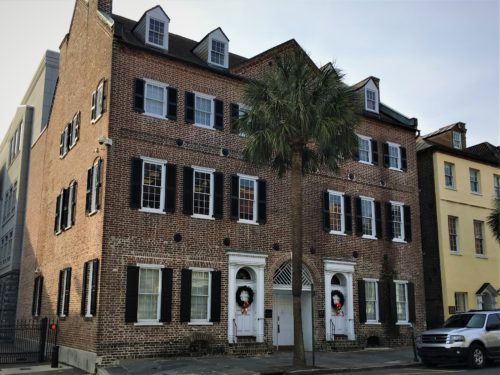
I took this to show you something interesting . . .
See the black circles?
Those are earthquake supports added after the earthquake in 1886
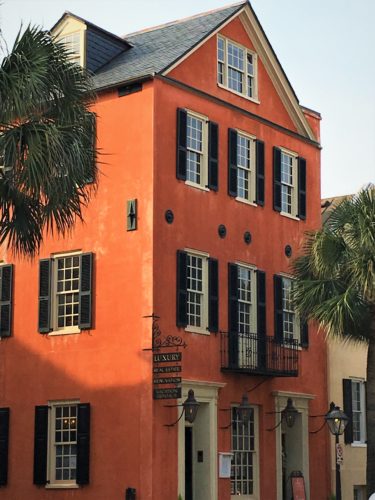
I just thought this one was pretty.
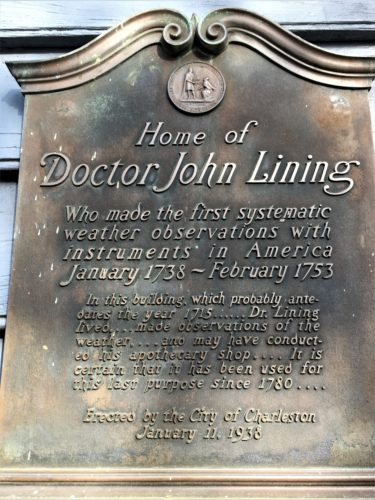
Interesting!
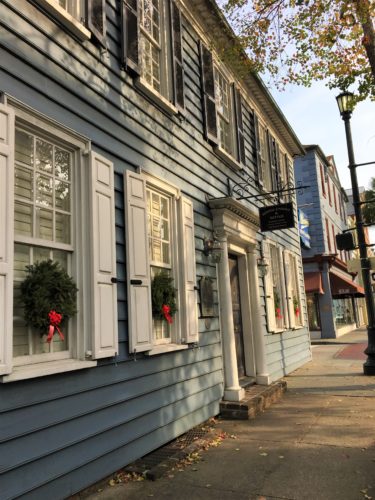
Dr. Lining’s former home.
Now an attorney’s office.
There’s an awful lot of attorney’s in this area, so I’m not surprised!

I liked this one too, although it looked a little better in person. : )
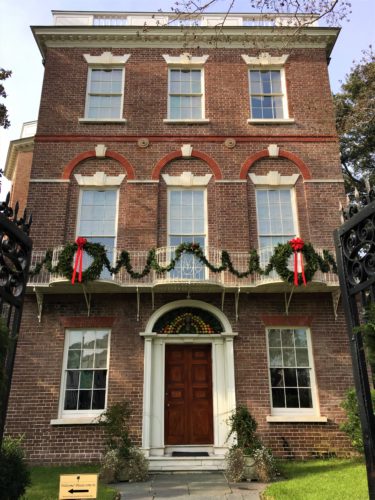
I took this for the door decoration.
(See next picture for a close-up)
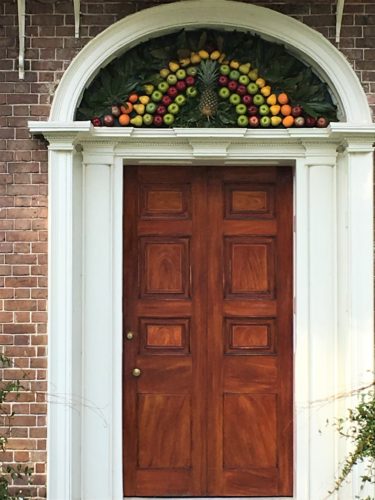
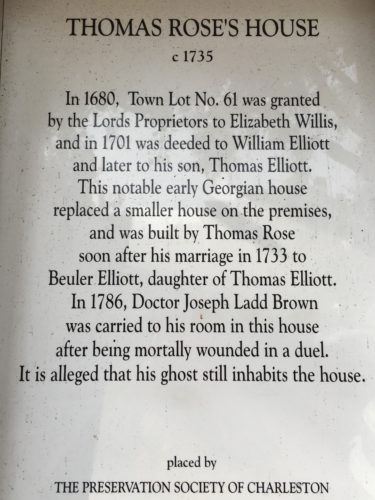
A bit of history!
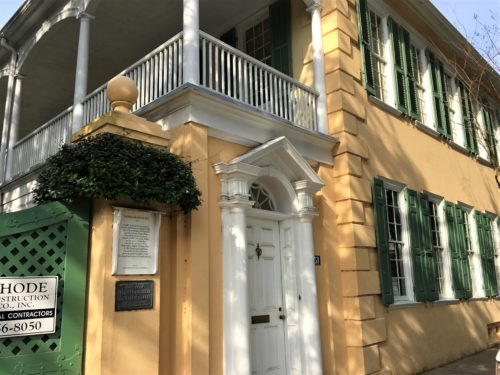
Mr. Rose’s former home
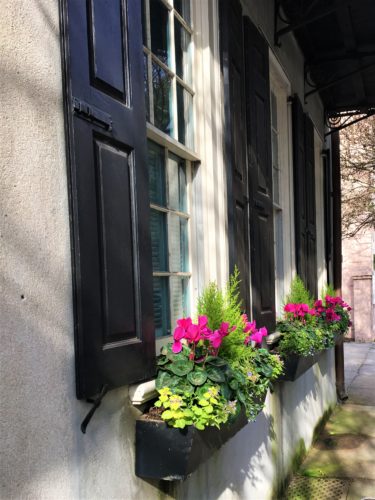
Many people had these flower boxes filled with color! In December!
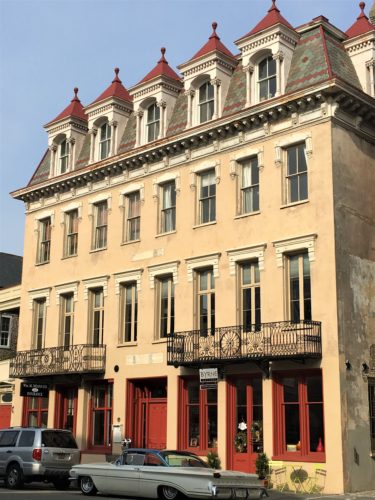
Liked the top of this one!
Halfway through the day, Blaine took me to a French Restaurant for lunch. Gaulart & Maliclet “fast and French”. No pictures of the food, there just wasn’t room as it was a tiny little place, with tiny little tables. If all the restaurants in France are like this, I’ll just do take-out, thank you very much. 😊 I had French Onion soup and he had the same, but added a turkey croissant. Everything was delicious!l And they don’t allow tipping! Apparently it’s a new trend some restaurant’s are trying out.
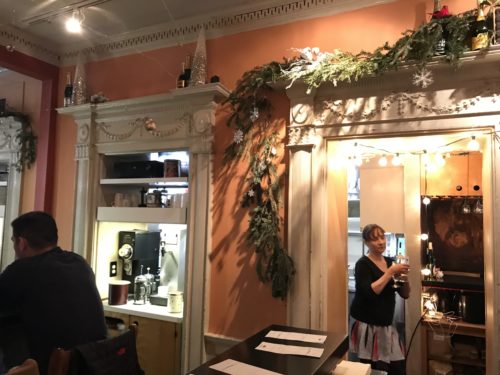
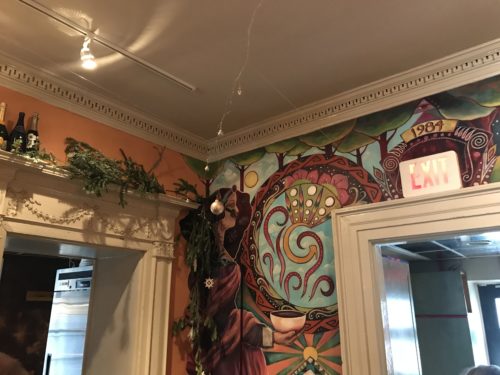
Once we finished walking around downtown, we drove across the Arthur Ravanel, Jr. Bridge for our next adventures.
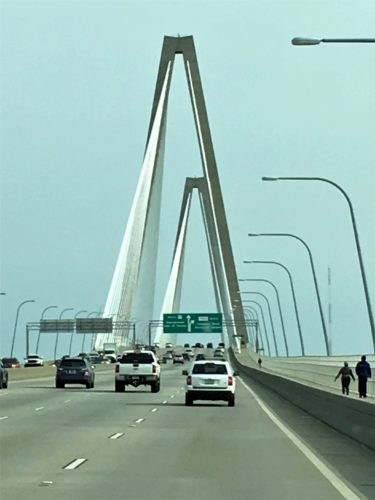
See the people on the side of the road?
That’ll be us later!
Now, I just know you’re wondering who this guy is that he got a bridge named after him. Well, he’s the one responsible for the bridge’s existence. Per Wikipedia (because that’s the only source I could find), “Raising financial support for a new eight-lane bridge over the Cooper River was a struggle 20 years in the making, prolonged by the state’s insistence that it could not afford such a bridge and by Charleston’s reluctance to provide any funds for the project. Several proposals were made for a toll bridge, but the mayors of Charleston and Mount Pleasant objected. When officials revealed in 1995 that the Grace Bridge scored a 4 out of 100 for safety and integrity, retired U.S. Congressman Arthur Ravenel, Jr. ran for the South Carolina Senate with a goal of solving the funding problem. He helped to establish the S.C. Infrastructure Bank and worked with local, state, and federal officials to create partnerships that helped to materialize the final funding.”
And there you have it! Or as Paul Harvey used to say, “And now you know . . . the rest of the story.” Technically, there’s much more to it, but I think this posting has more than enough for today, and there’s still more to come!
These are pictures (talk about stating the obvious!) I took off the internet. We were never in a position to take the entire bridge.
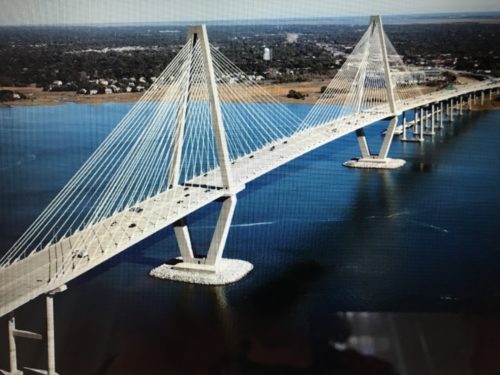
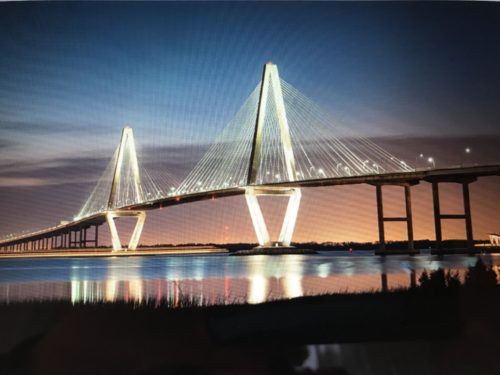
On the other side of the bridge, in the town of Mt Pleasant, is our next stop. Fort Moultrie. It’s not nearly as famous as Fort Sumter. We looked into going there, but the ferry ride over was cost-prohibitive for us. Fort Sumter was the place where the first shots of the Civil War were fired. Occupied by Union troops, the Confederates fired upon it and eventually took the fort.
Anyway, back to Fort Moultrie. We were able to snag a private tour! Sounds impressive, but we didn’t do anything except show up by ourselves in the middle of December on a cold weekday near the end of the day.
As we were waiting for the tour time to start, we perused the small museum they have there, part of which was a section on slavery in Charleston, South Carolina. As sad as it is for us to see, I’m sure it’s even worse for all those whose history involved this – both black and white.
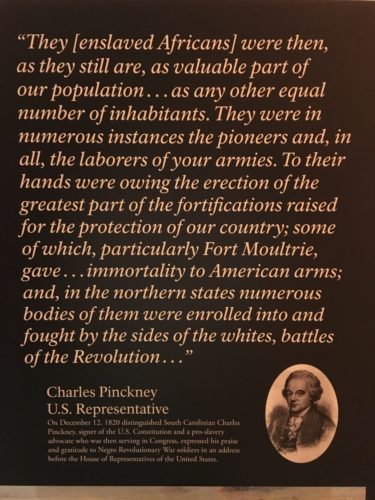
You may not remember from previously in this blog, but this guy is buried along with John Rutledge in St. Michael’s cemetery.
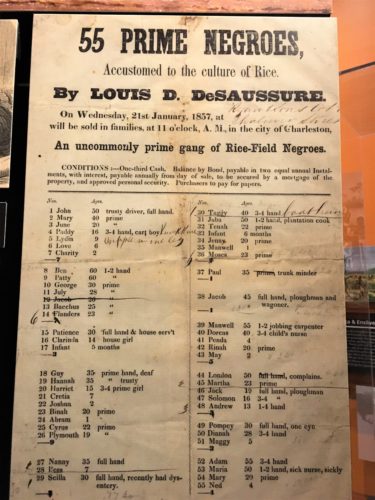
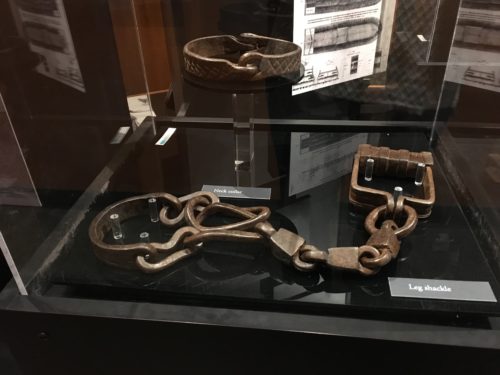
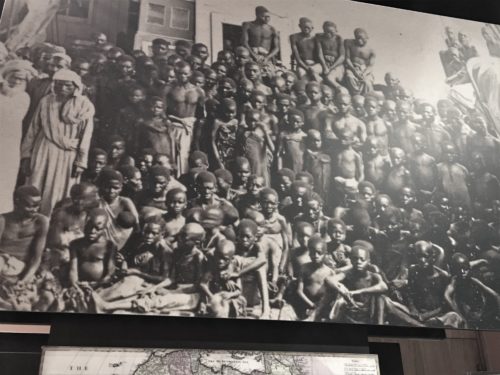
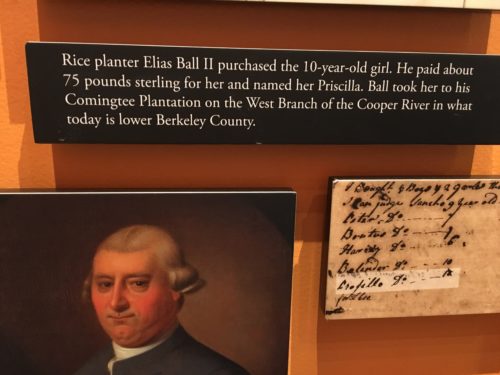
Here’s an enlightening moment:
The media was just as bad in the 1700’s as it is today at spinning tales!
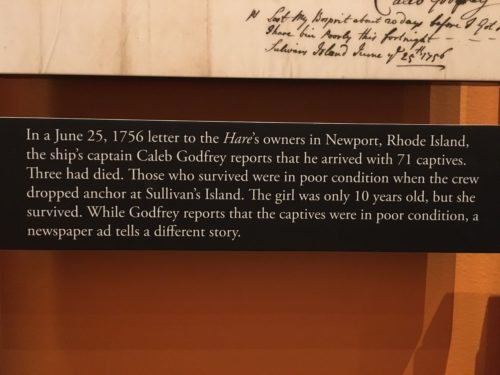
The ship’s captain reported the poor condition of the slaves he’d brought . . .
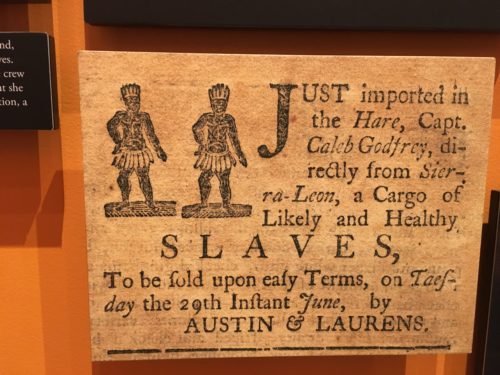
The media spun it differently.
Yes, it’s an ad, but we’ve seen several places in our brief time traveling where the media deliberately spun things.
Our guide was a volunteer from Wisconsin named Dale. He did a great job! The fort has been in use for the Revolutionary, Civil, WWI, WWII and whatever wars were in between Civil and WWI. It’s now included in the National Park System.
Here’s just a couple of interesting facts we learned.
- The first fort was built of sand and palmetto wood, and during the Revolutionary War, the bombardments pretty much bounced off it.
- Edgar Allen Poe was stationed there. He actually paid someone to finish his term of service for him so he could become a writer. Apparently, you could do that back then. 😊
- General William Tecumseh Sherman (of Union fame responsible for the taking of Atlanta) was once stationed there.
- Osceola was imprisoned here. He was a leader of the Seminole Indians and led a relocation resistance effort against the US Army during the 1830’s. It was the longest and most expensive Indian war fought by the United States. (Over 2,000 soldiers were killed and an estimated $50 million was spent.) Osceola died in the prison in January 1838. His death had nothing to do with being imprisoned. He was in ill health when he arrived. After his death, the attending doctor cut off his head (apparently a fairly common practice for everyone at the time, YUK!!) for medical research.
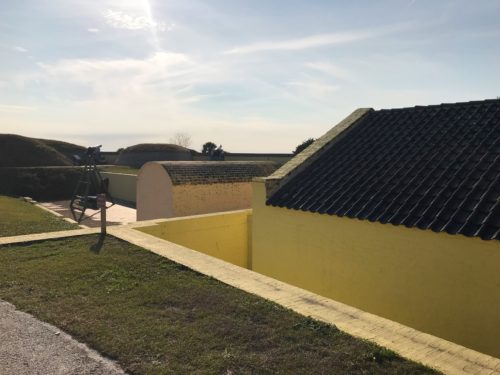
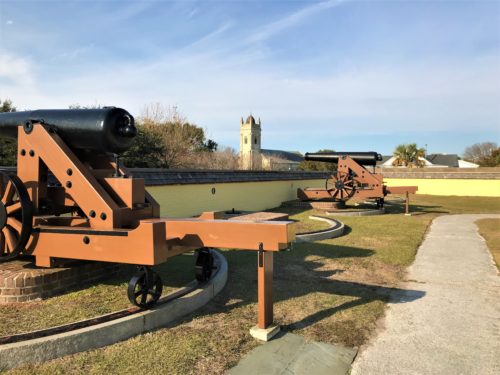
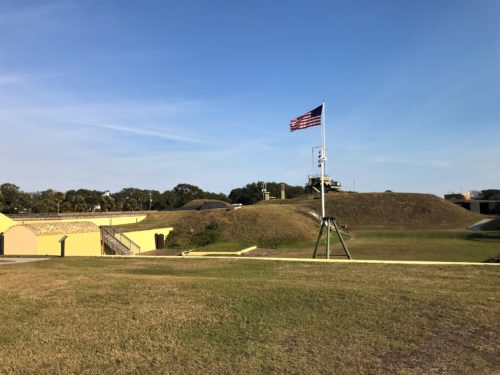
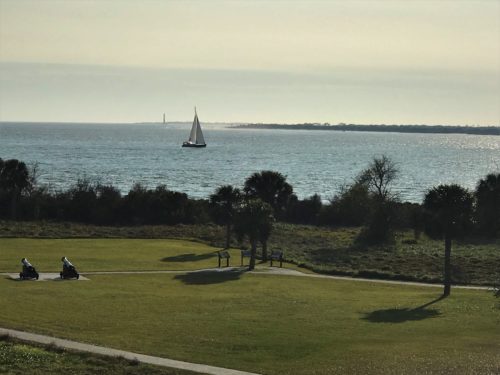
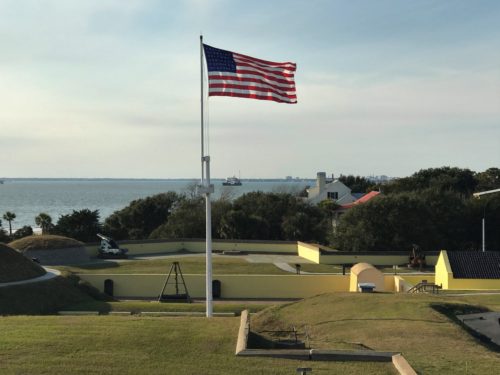


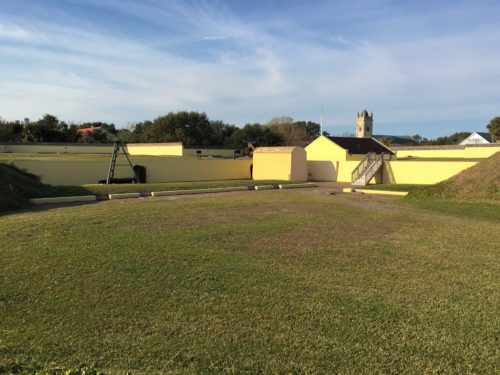
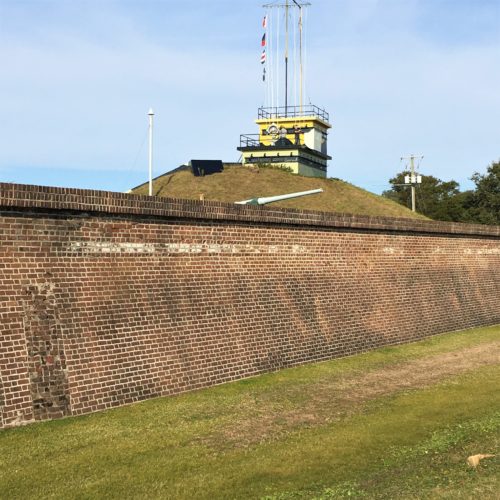
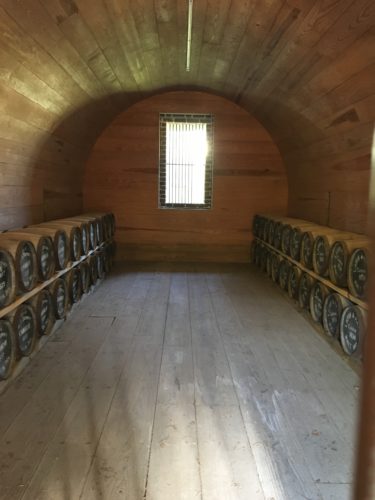
Inside a powder magazine

I was inside the magazine
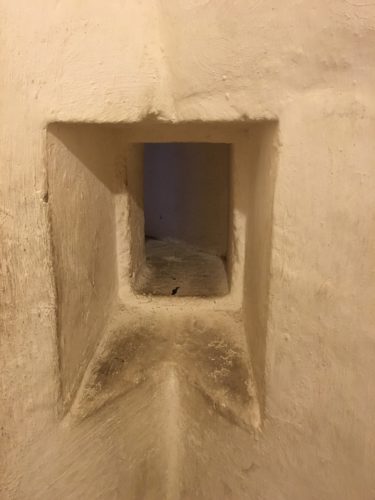
Since there are no windows, this cubby was built to set a lantern in the original powder room.
It considerably lowered the risk of knocking over the lantern.
I’m sure you can guess why that was so important. : )
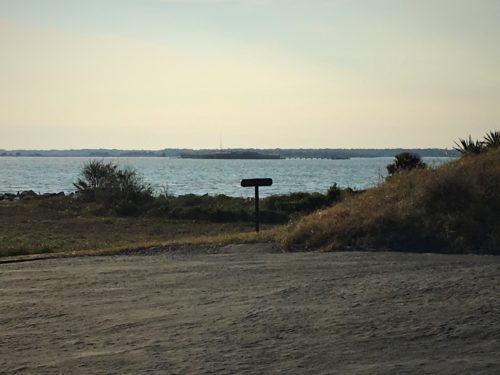
Fort Sumter across the water
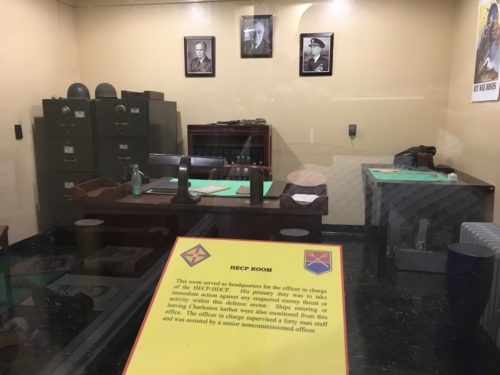
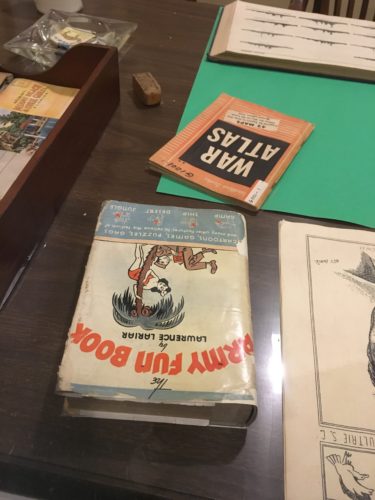
After about an hour and a half, we drove back to the foot of the bridge. There’s a 2.5 mile walkway across the bridge specifically designated for pedestrians and bicycles. We were quite surprised at how many people were using it! What a unique experience! And a beautiful bridge! Being the end of the day, we walked 1.5 miles one way to the end of the cables and back.

The view from the parking lot
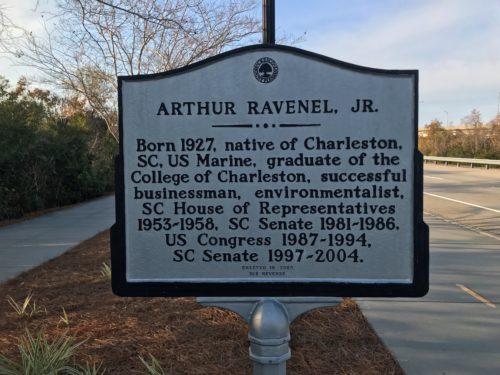
The start of the walkway.
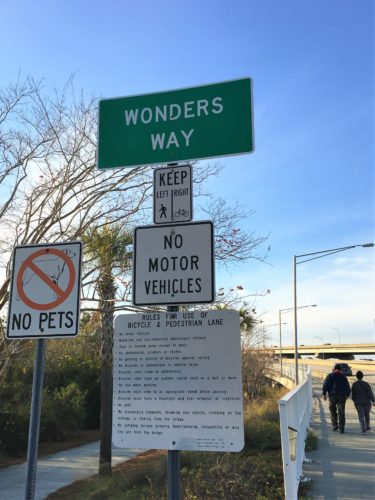
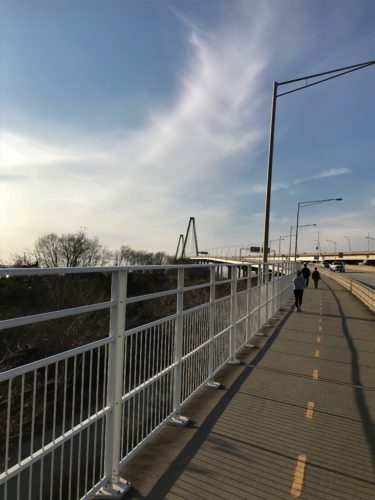
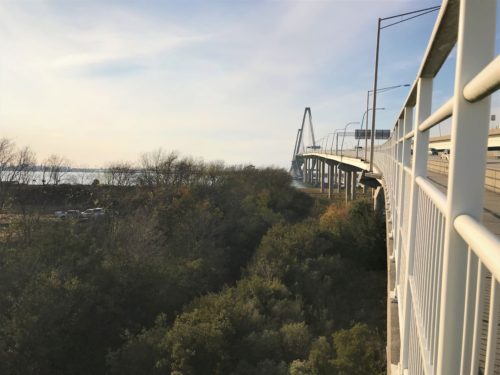
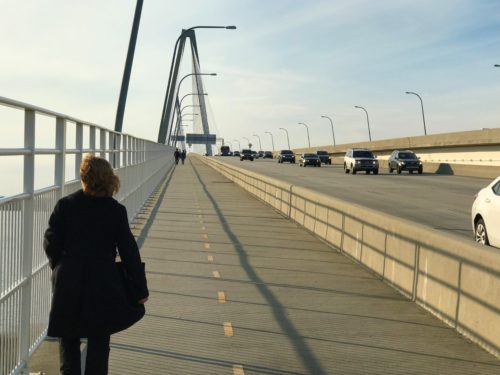
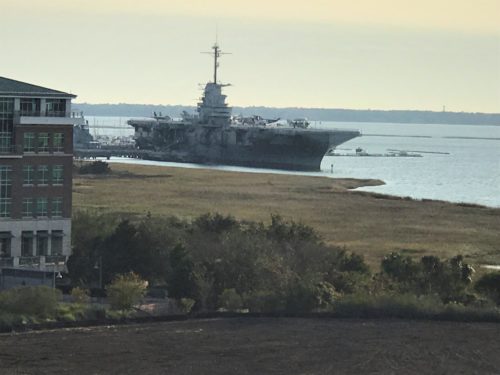
The USS Yorktown
For some reason, this picture makes it look like it’s recently been on fire. Shadows, I guess. The ship was just fine.
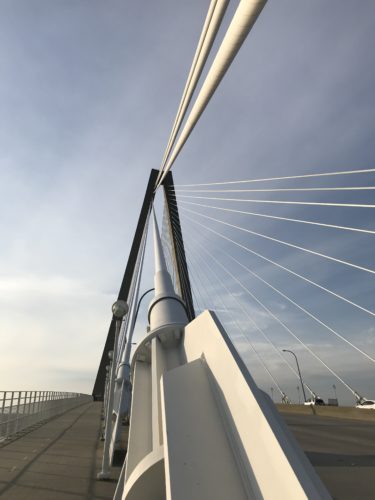
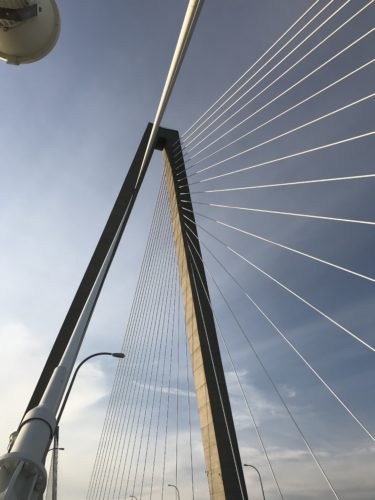
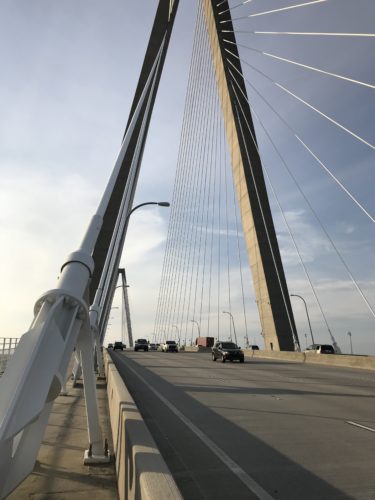
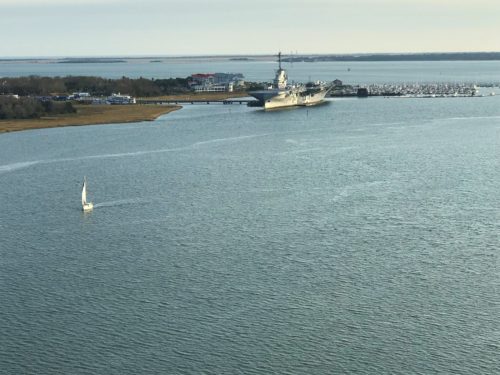
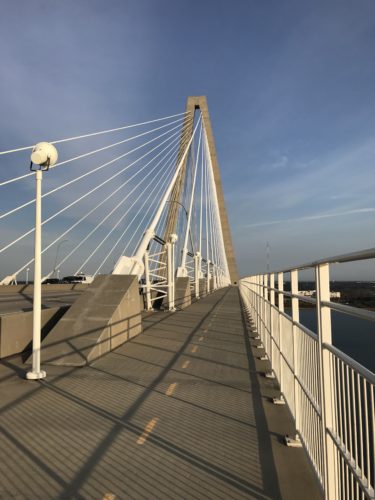
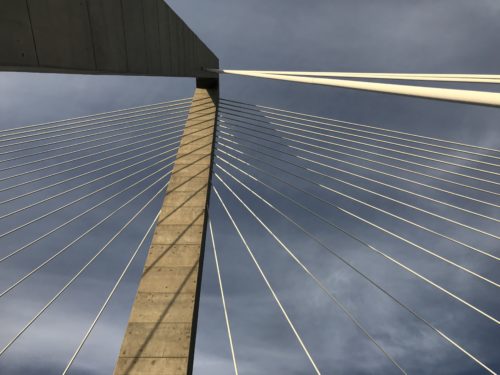
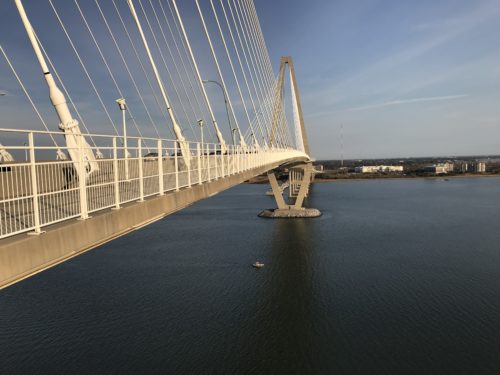
We’re 186′ above the water.
Too far to jump. . .
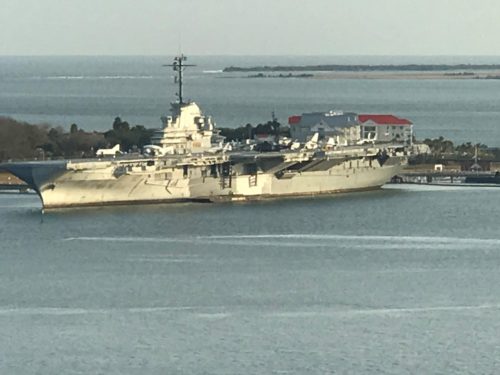
That looks better!
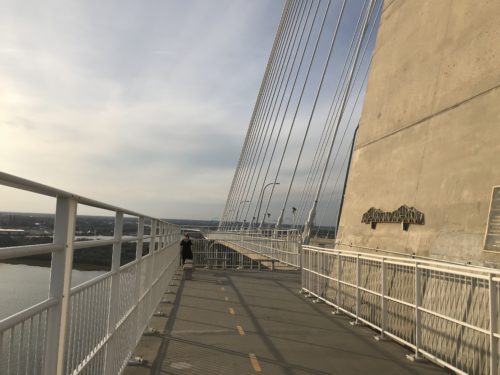
That mark on the support that looks like a car? That a model of the former bridge. It’s made from pieces of the old bridge.
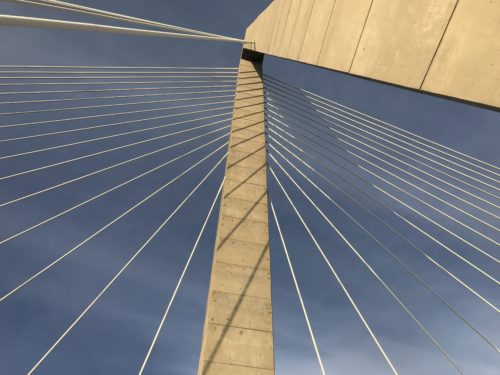
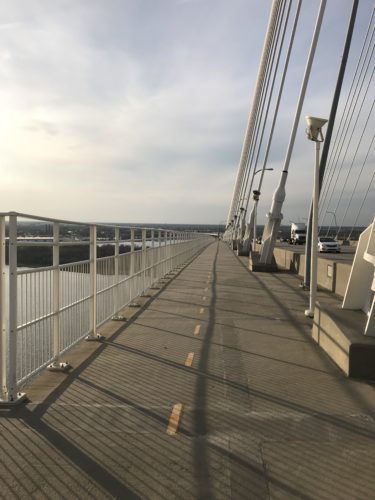
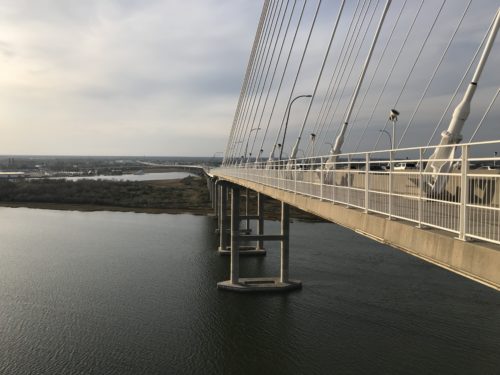
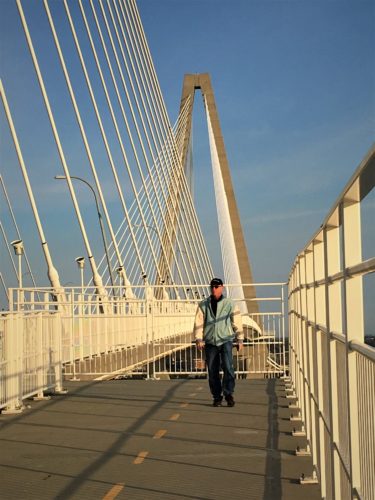
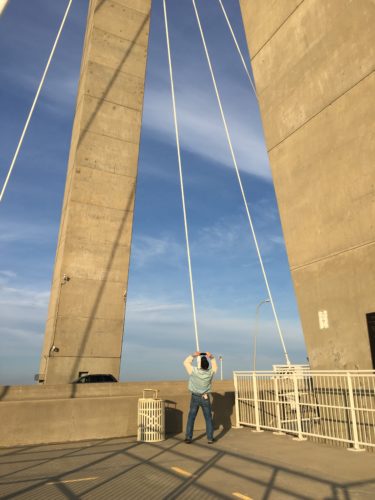
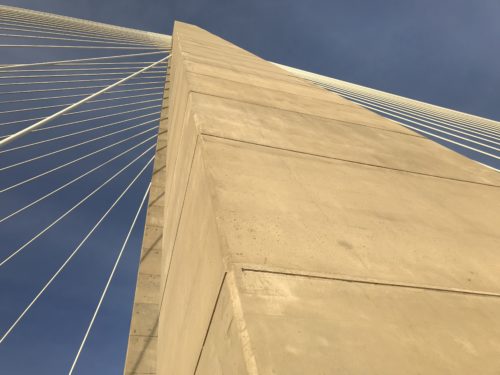
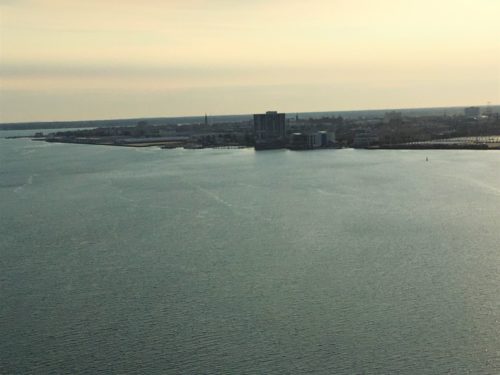
Nearing sunset.
Time to head back!
Besides, I’m hungry for hushpuppies!
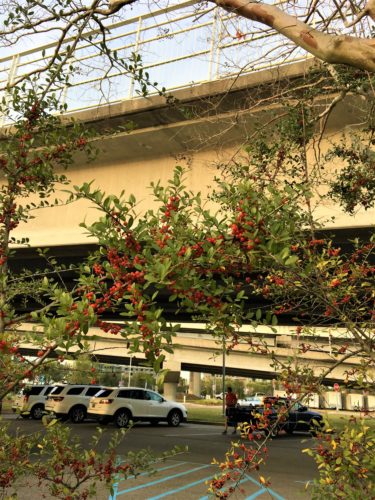
Heading to the Jeep
Then it was time for dinner, so off we went back across the bridge to downtown Charleston. Hyman’s is the place we chose for tonight, mostly because the other day we were given a sample of their hushpuppies as we walked down the street. Yummy, yummy in my tummy!
Great dinner and some unique reading material! There’ve also been a bunch of famous people who’ve eaten here as attested to by the signed photographs and the name plaques on the tables. Here’s who supposedly ate at ours. (Personally, I think they just randomly picked names of people who’ve been there, but it was still fun!)
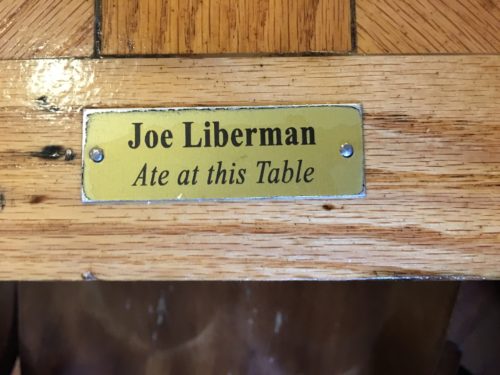
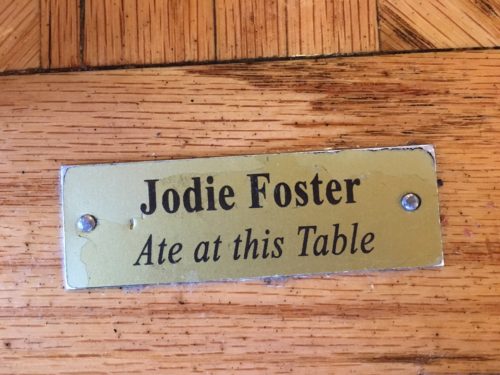
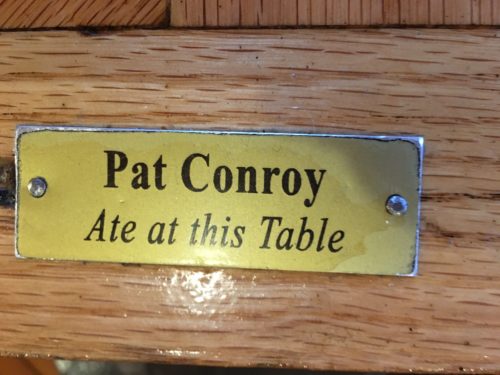
We didn’t know who this was.
Turns out he’s an author.
Two of his works are “The Prince of Tides” and “The Great Santini”.
Ohhhhhh . . .

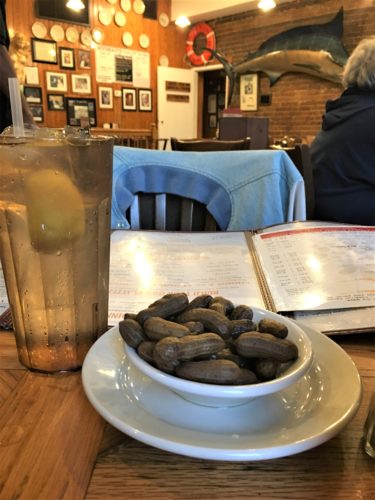
There’s a reason Blaine’s chair sits empty.
He left his wallet in the Jeep and had to hoof it back to get it shortly after we sat down. YIKES! It wasn’t close by, but he made pretty good time. Much faster than I would’ve!
The bowl of weird-looking stuff is boiled peanuts. I opened one, tasked it and promptly had the waitress remove them from the table.
They’re soft and mushy and all the rage down South.
YUKKY!
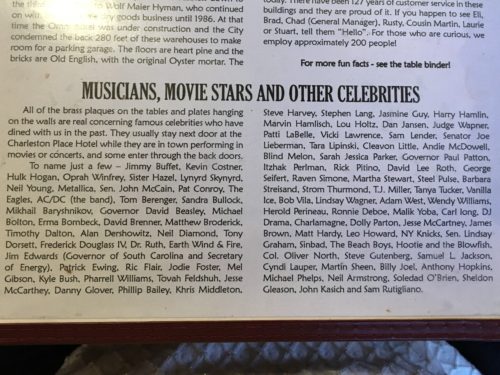
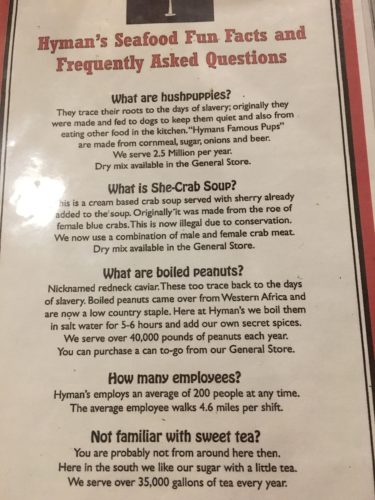
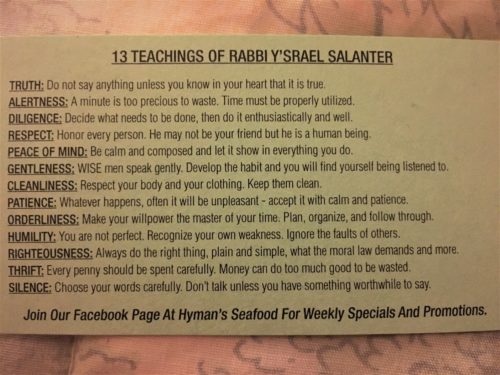
FYI – the owners are Jewish, but they share some Christian too.
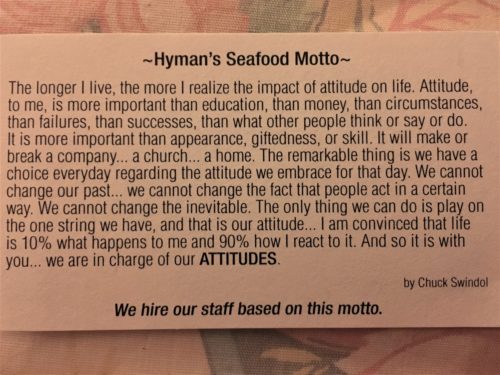
Like this one.

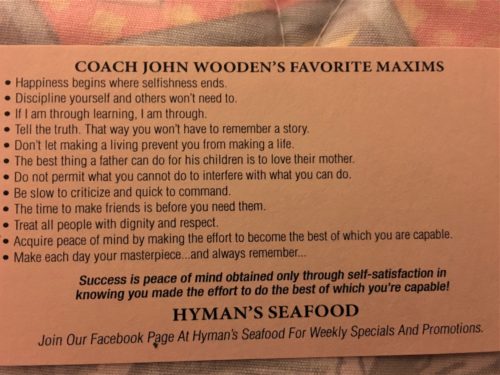
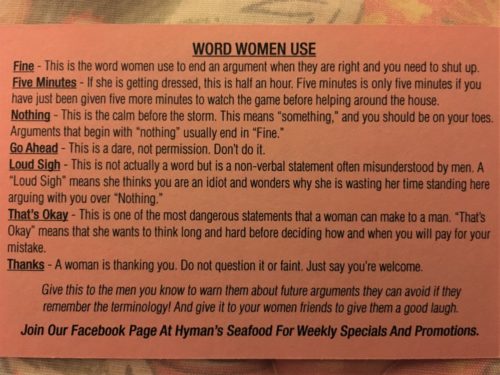
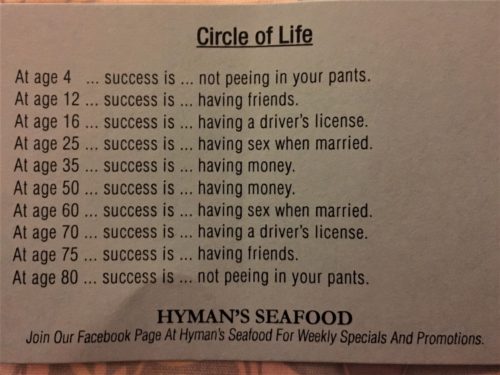
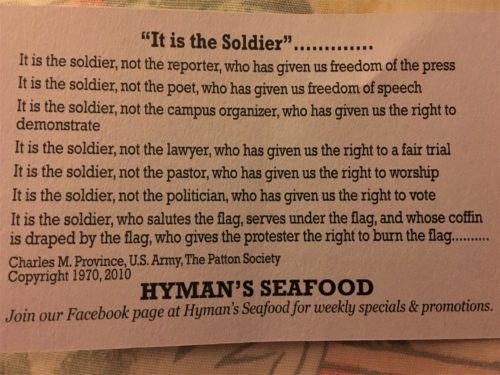
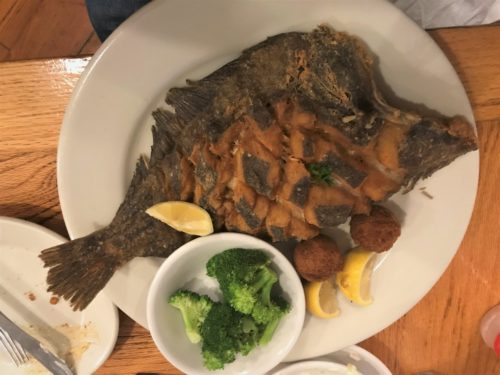
Blaine’s dinner.
Crispy Flounder. They score it and fry it. Whole. But head removed, although I think it looks like it still has a face. Don’t you?
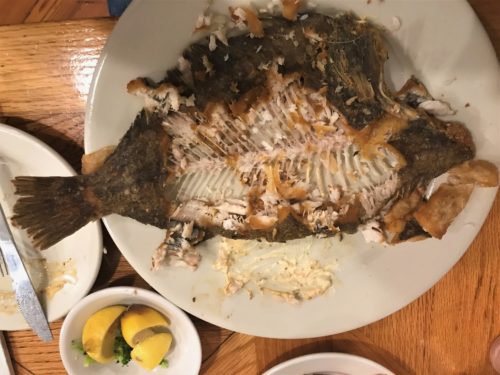
The aftermath.
On to the Theatre!

Can I say AMAZING too many times? The Sound of Charleston was every thing it was advertised to be and even more! The quality of music was astounding! And the variety! We were privileged to listen to:
- The first chaiclarinet from the Charleston Symphony, Charles Messersmith accompanied by a superb pianist, Ghadi Shayban. I’ve never in my life heard a clarinet played like that!
- A folk musician, Bart Saylor who played a variety of instruments (guitar, mandolin, banjo, harmonica and mountain dulcimer) and sang a variety of Civil War Era songs (including a couple of Christmas ones), joined a few times by our narrator for the night, co-director Bill Schlitt.
- The narrator himself was incredible! Full of vim and vigor and interesting information! One of which was sharing the fact in true story-telling form about John Newton worshiping in this church for a couple of weeks before he went home and wrote “Amazing Grace”.
- A woman named Ann Caldwell who is one of Charleston’s foremost interpreters of gospel spirituals and the Gullah (aka Sea Island Creole) dialect. She taught us a “call and response” spiritual and then she sang “Amazing Grace” a cappella – Stunning!!
- They closed the evening (waaaayyyy too soon!!) with a four-handed rendition of “Rhapsody in Blue” by George Gershwin. The previous pianist I mentioned along with a woman in a wheelchair, the co-director, Maida Libkin. I can’t even begin to describe this for you! There simply aren’t enough superlative words!
Wonderful day! Magnificent way to end our evening!
